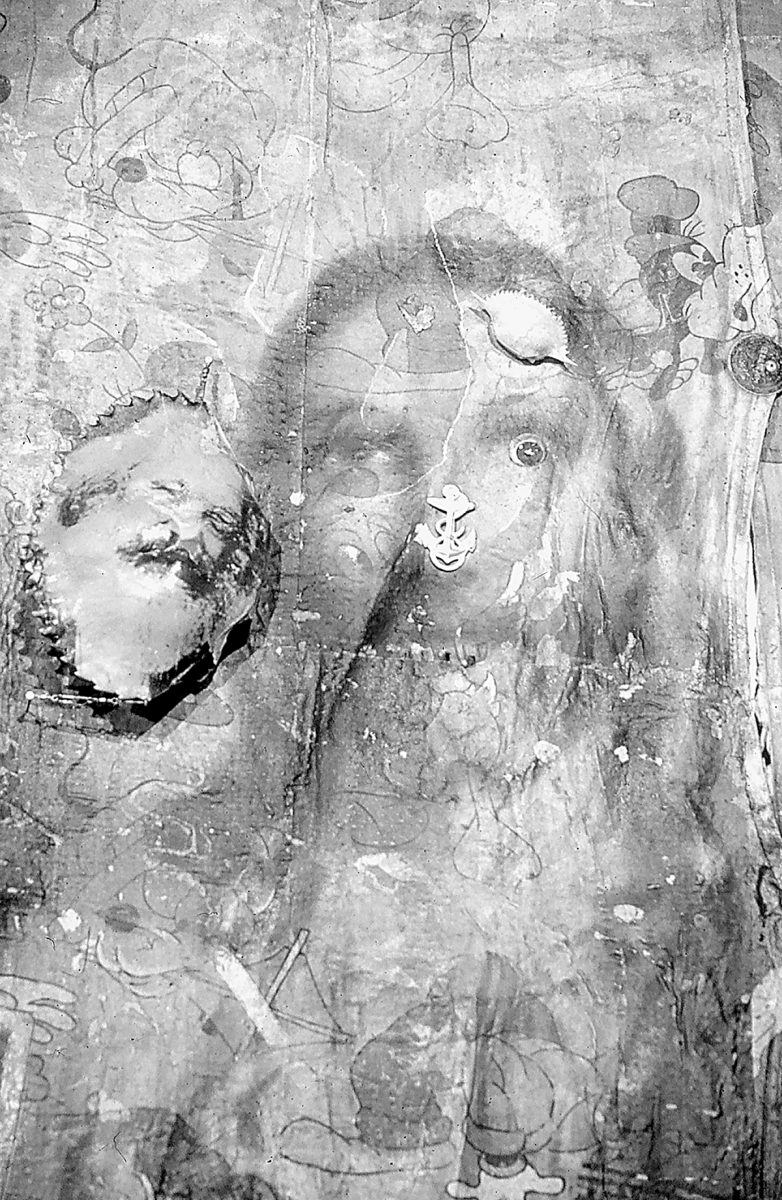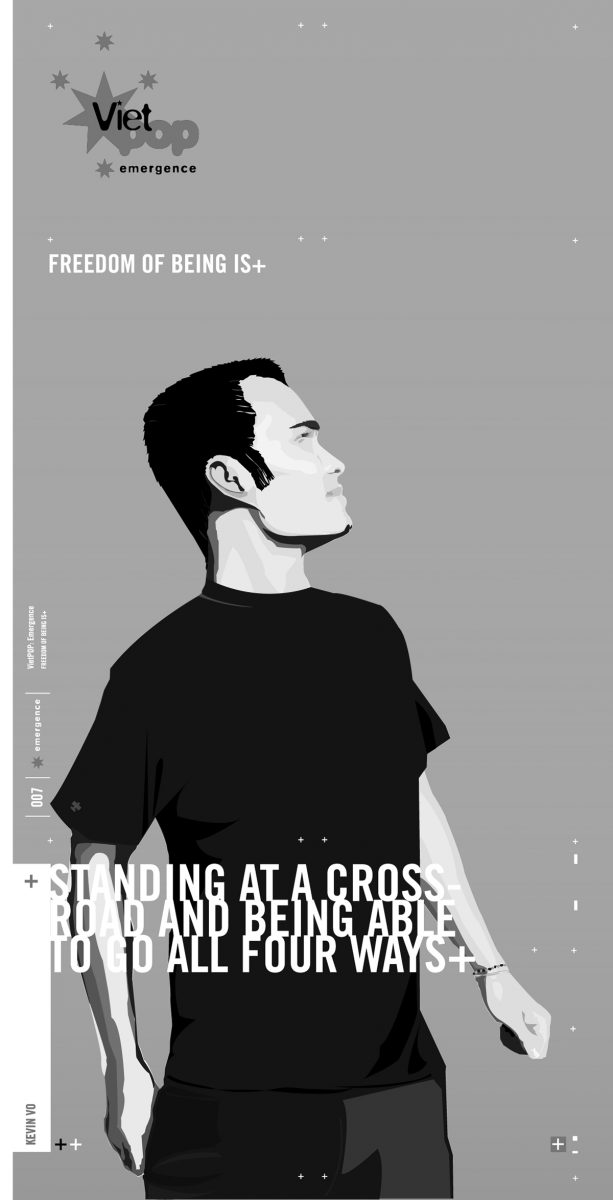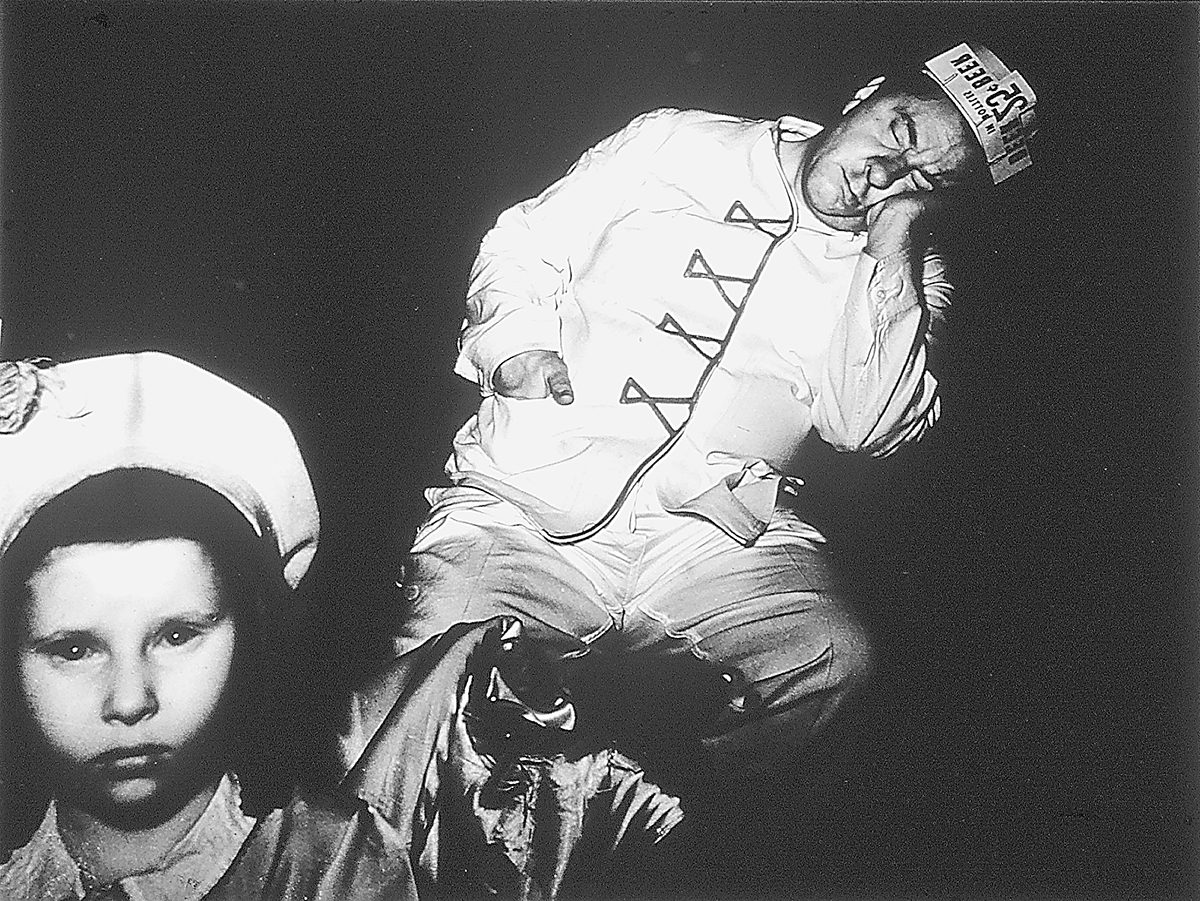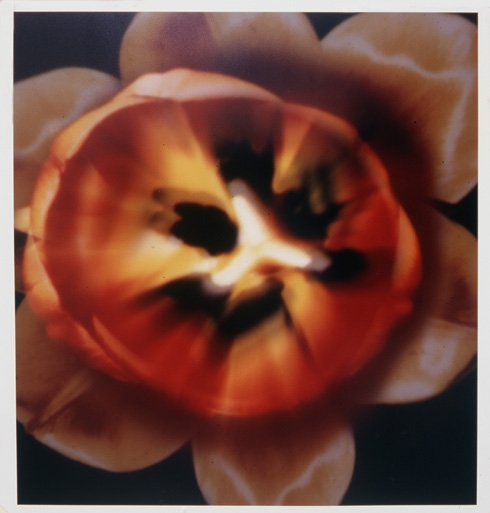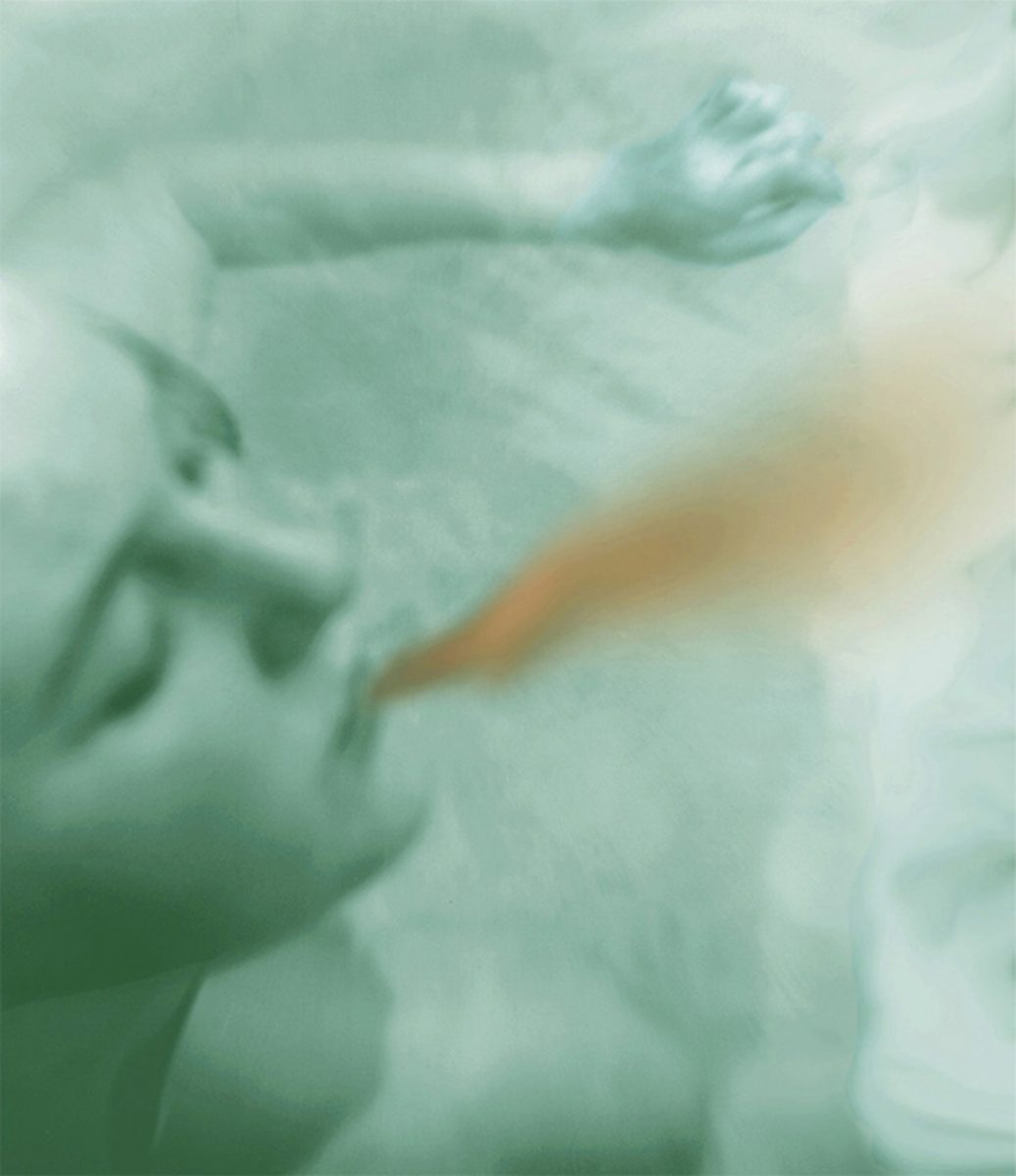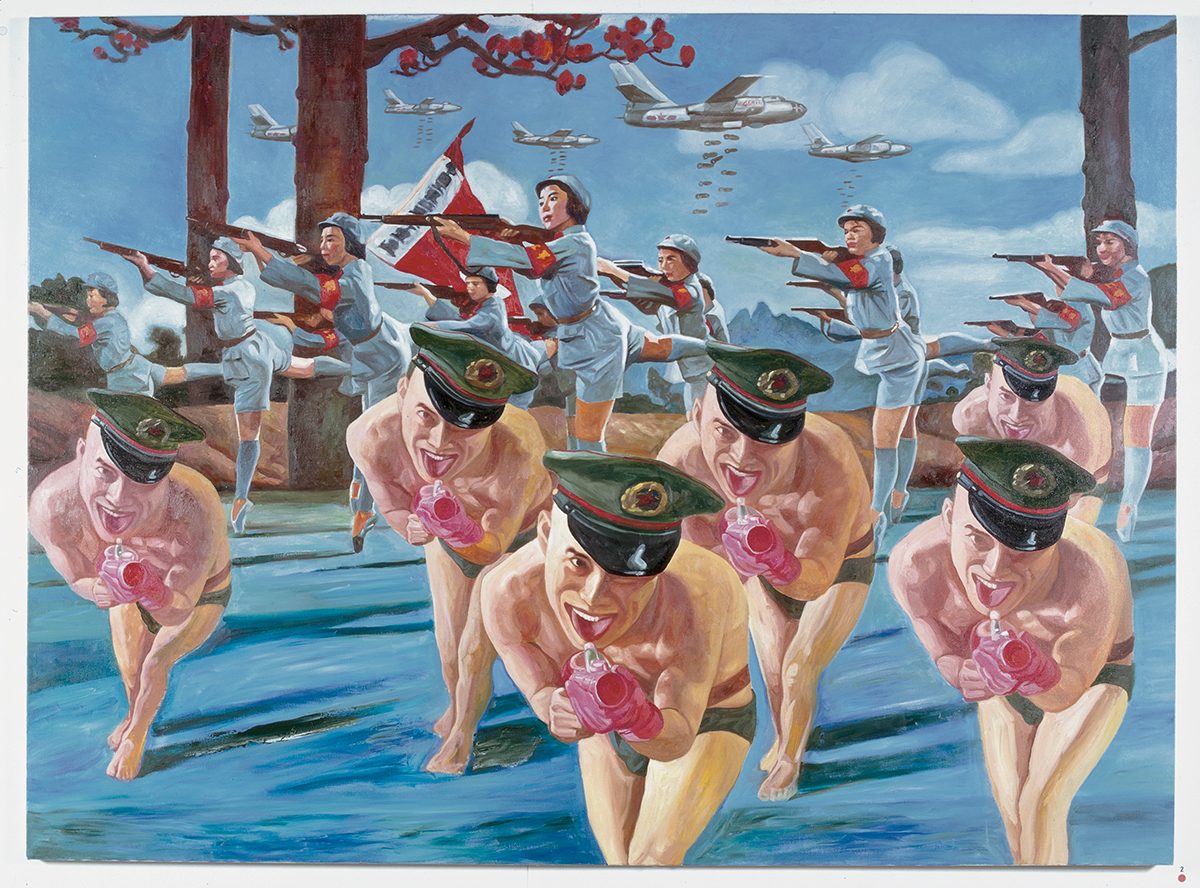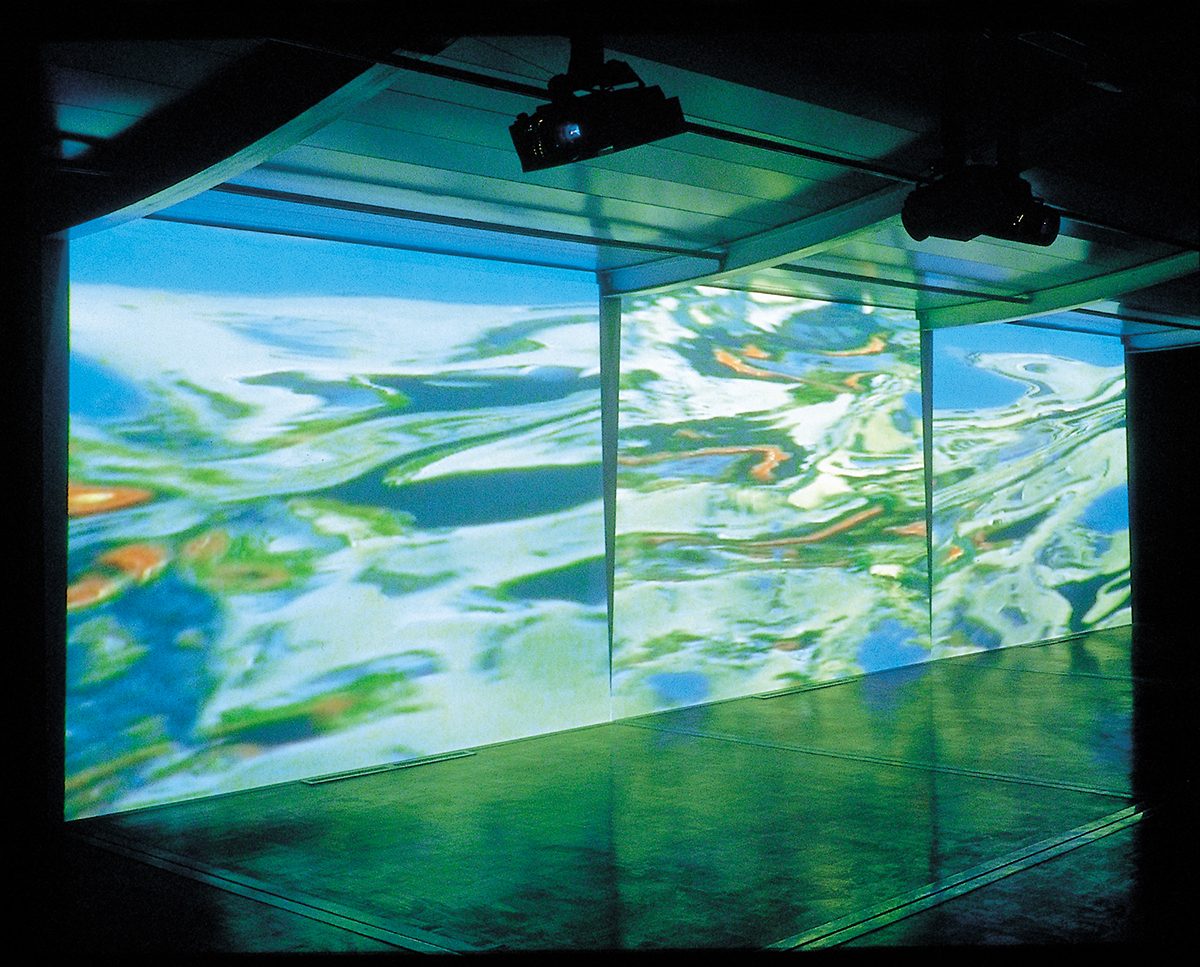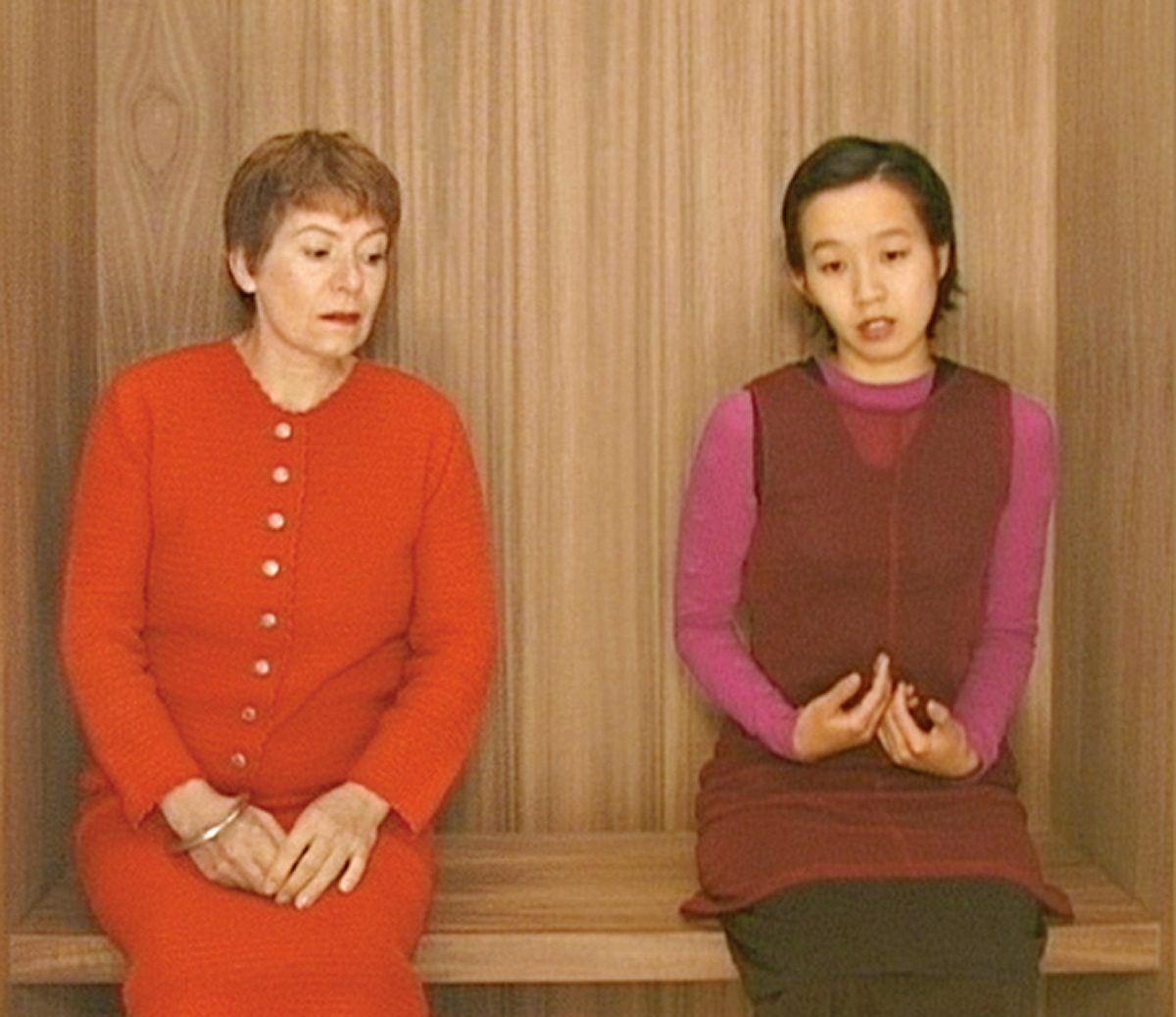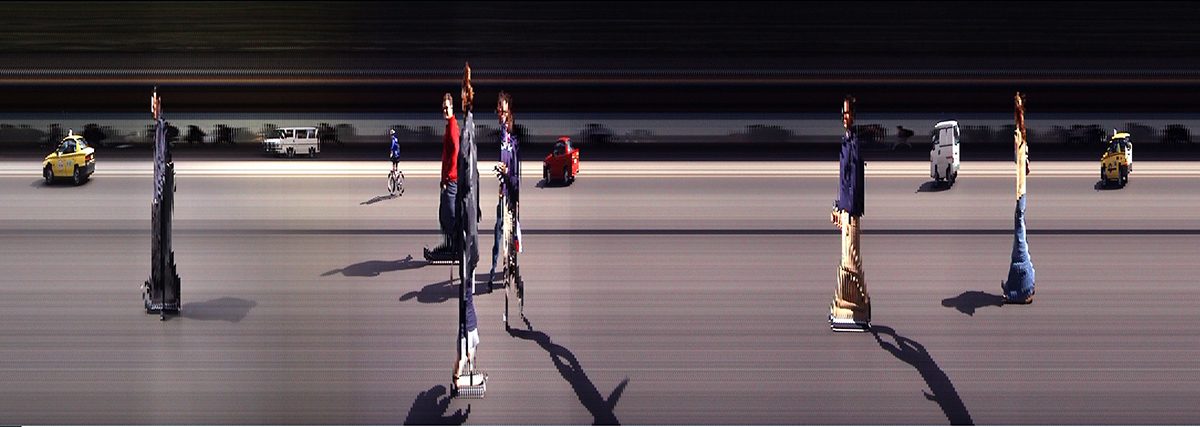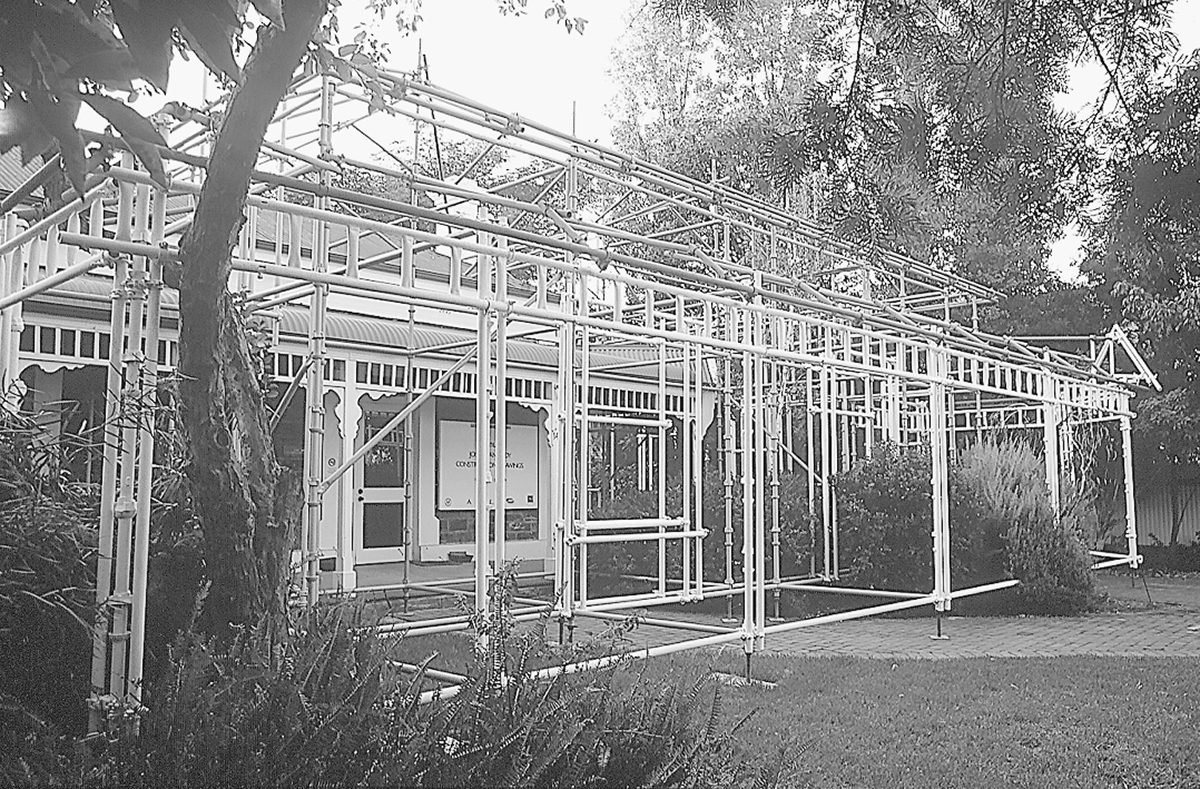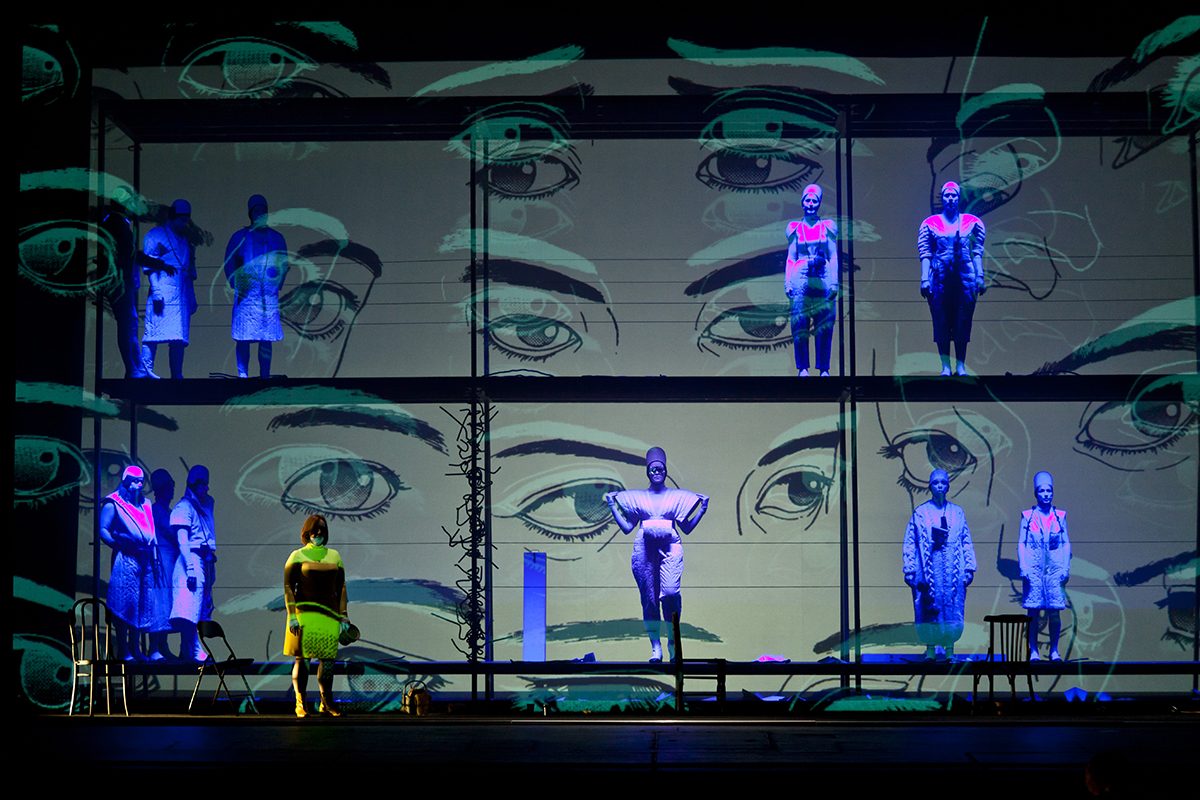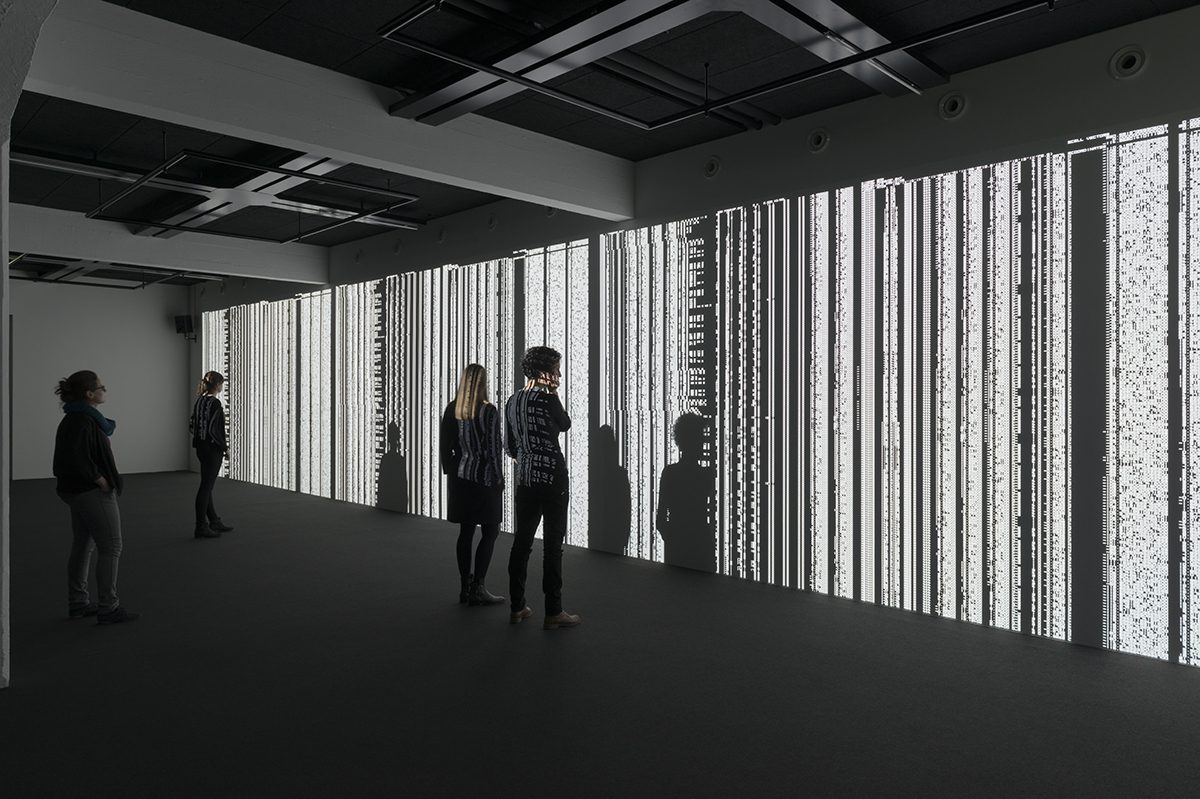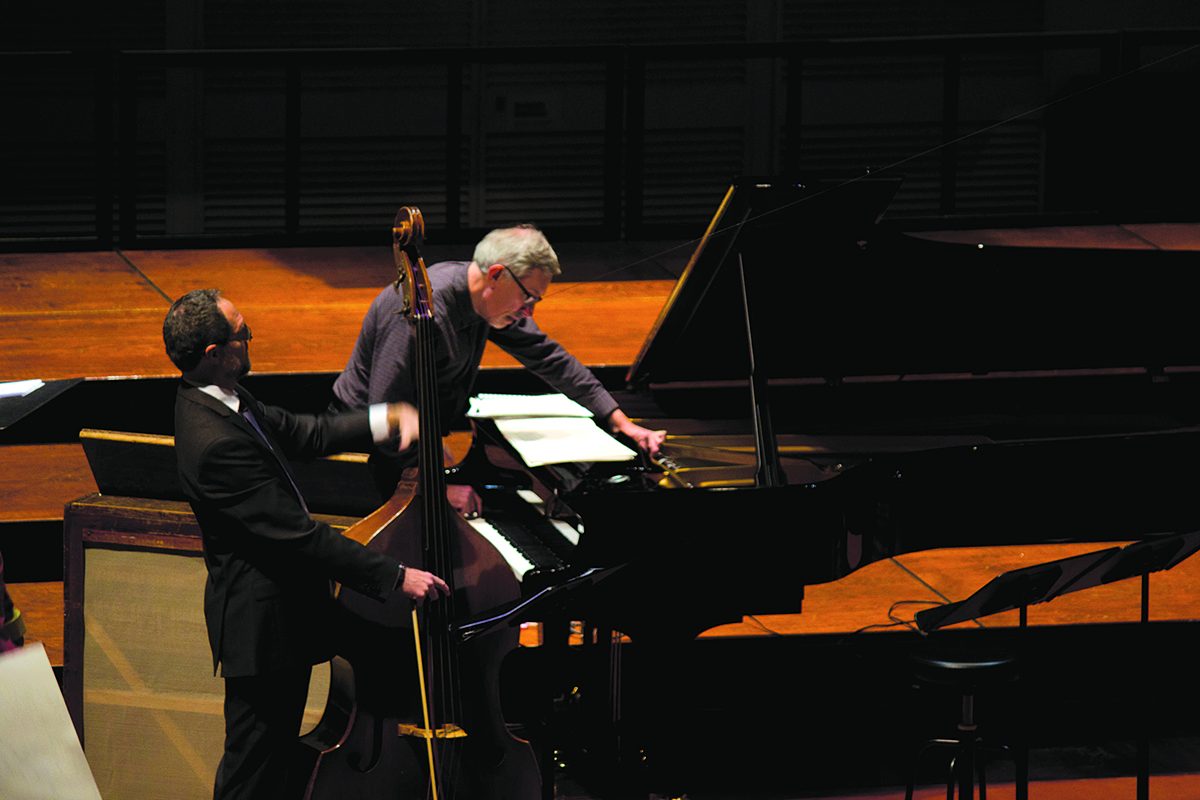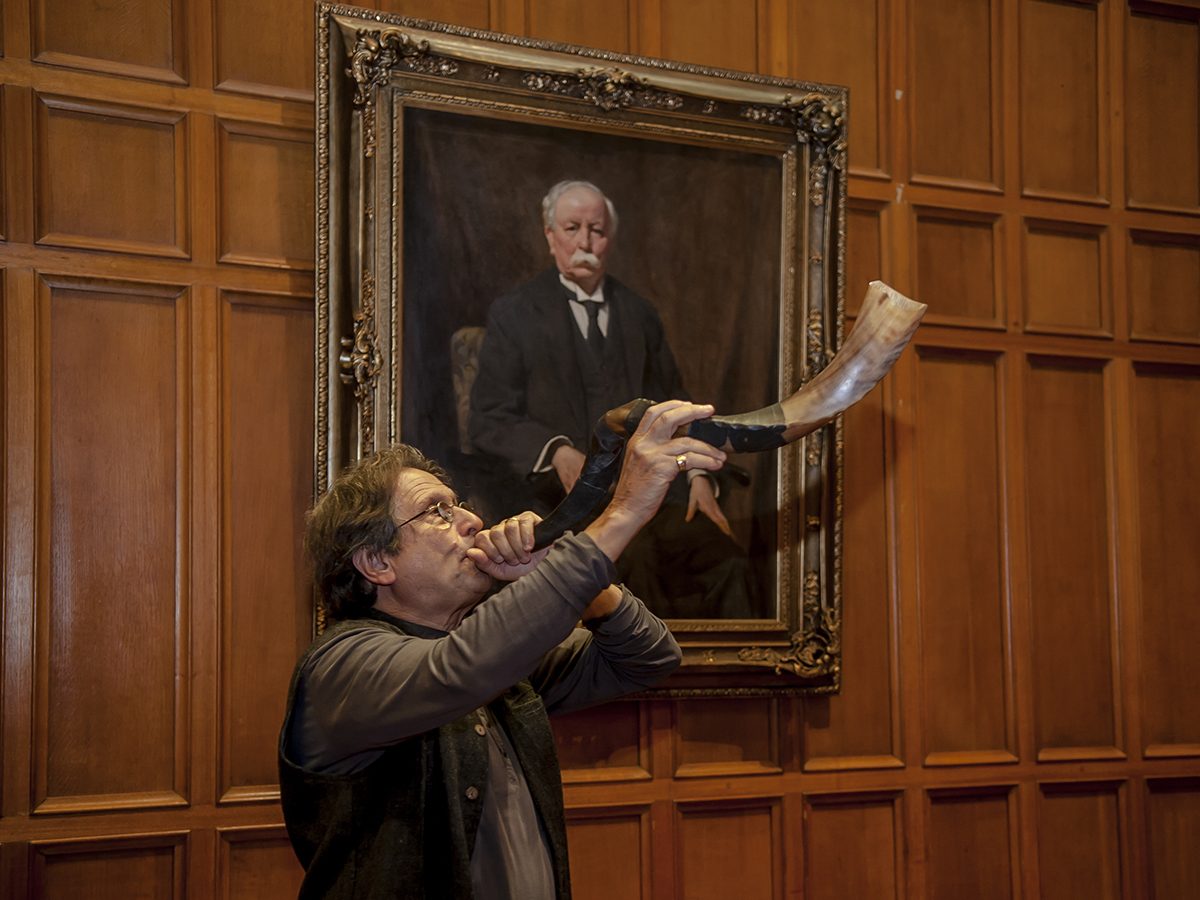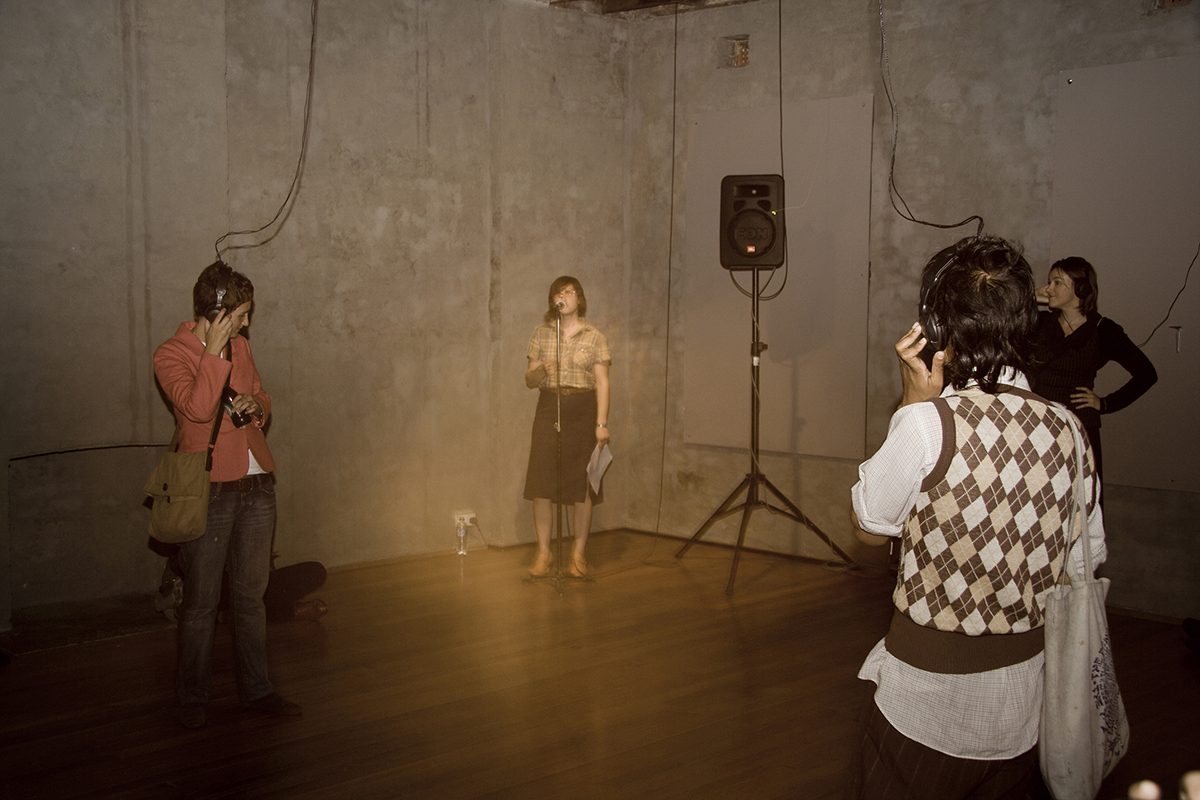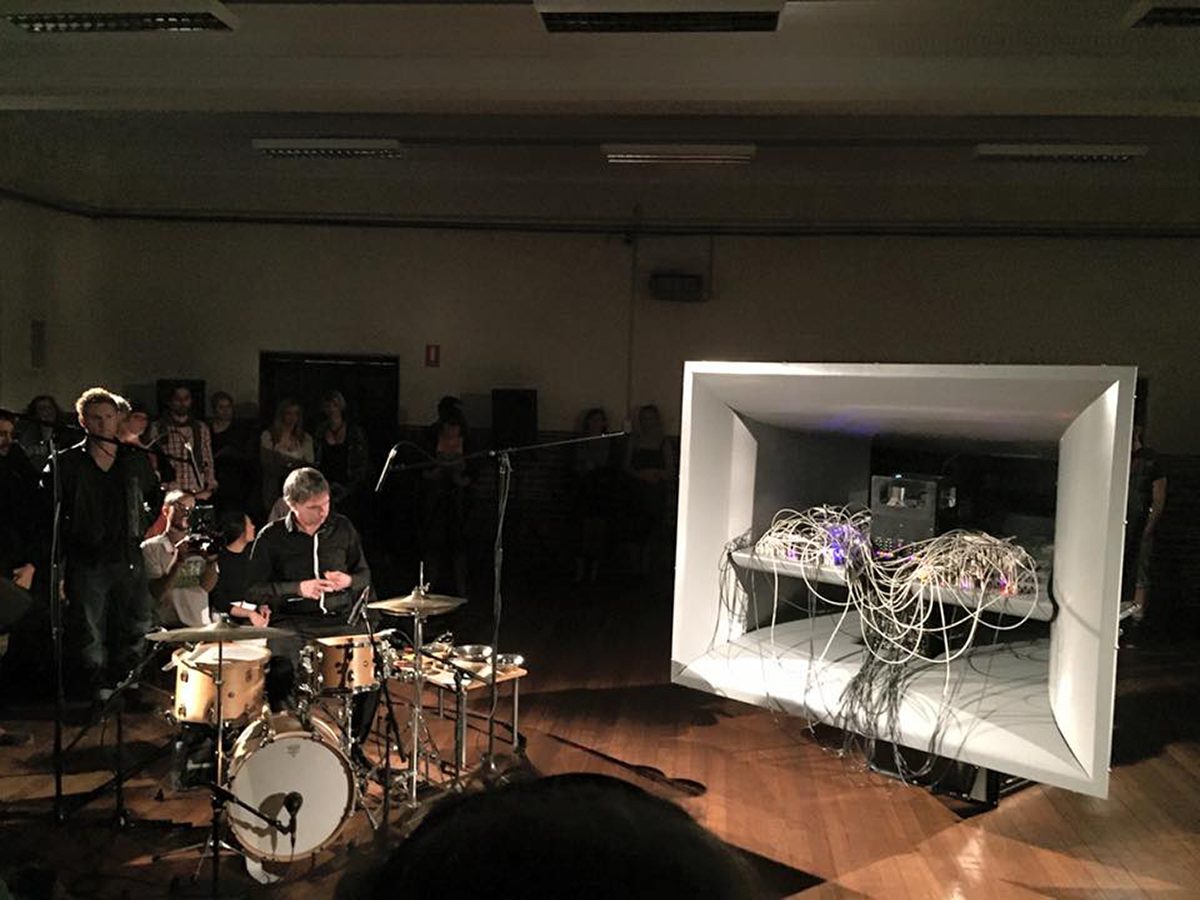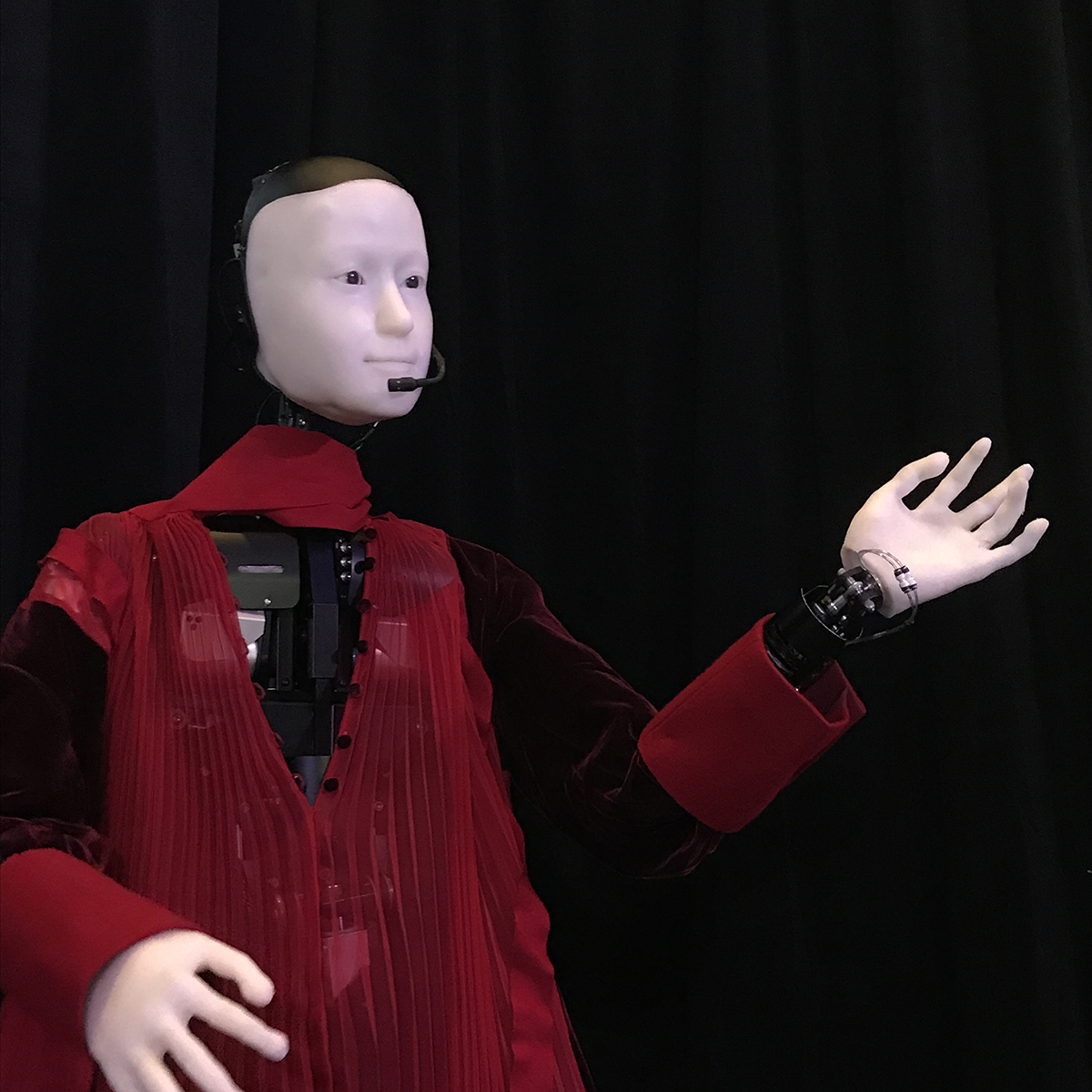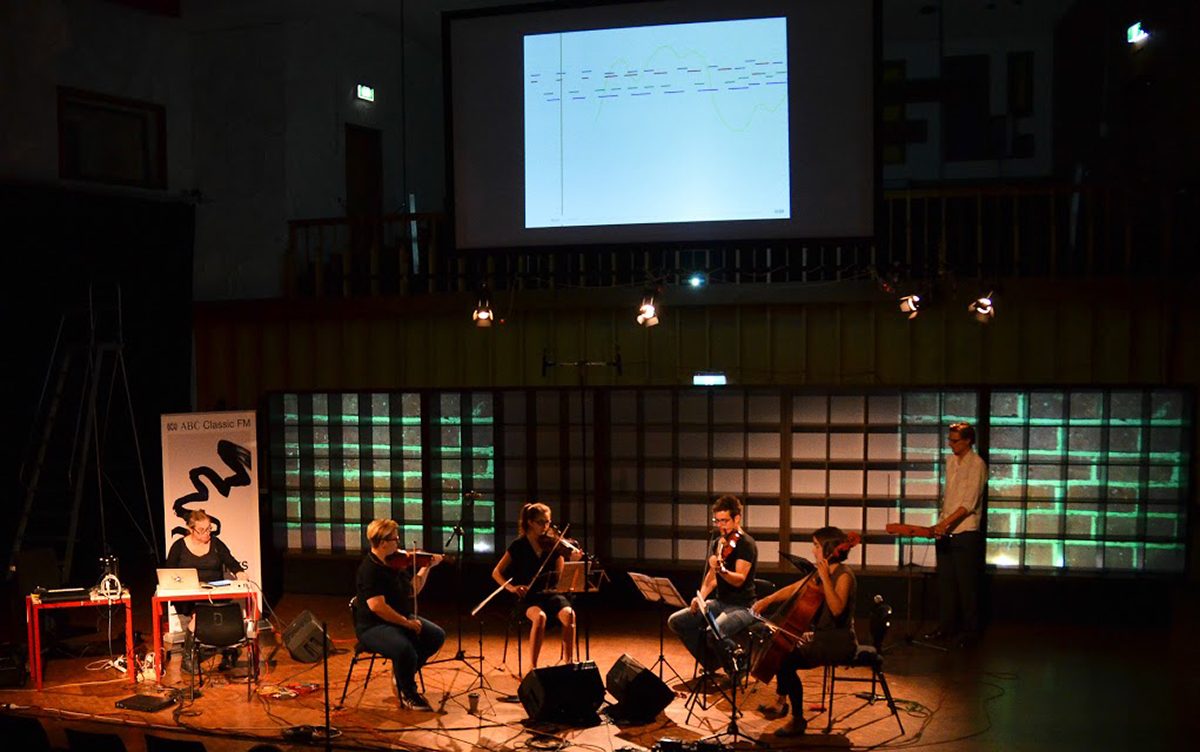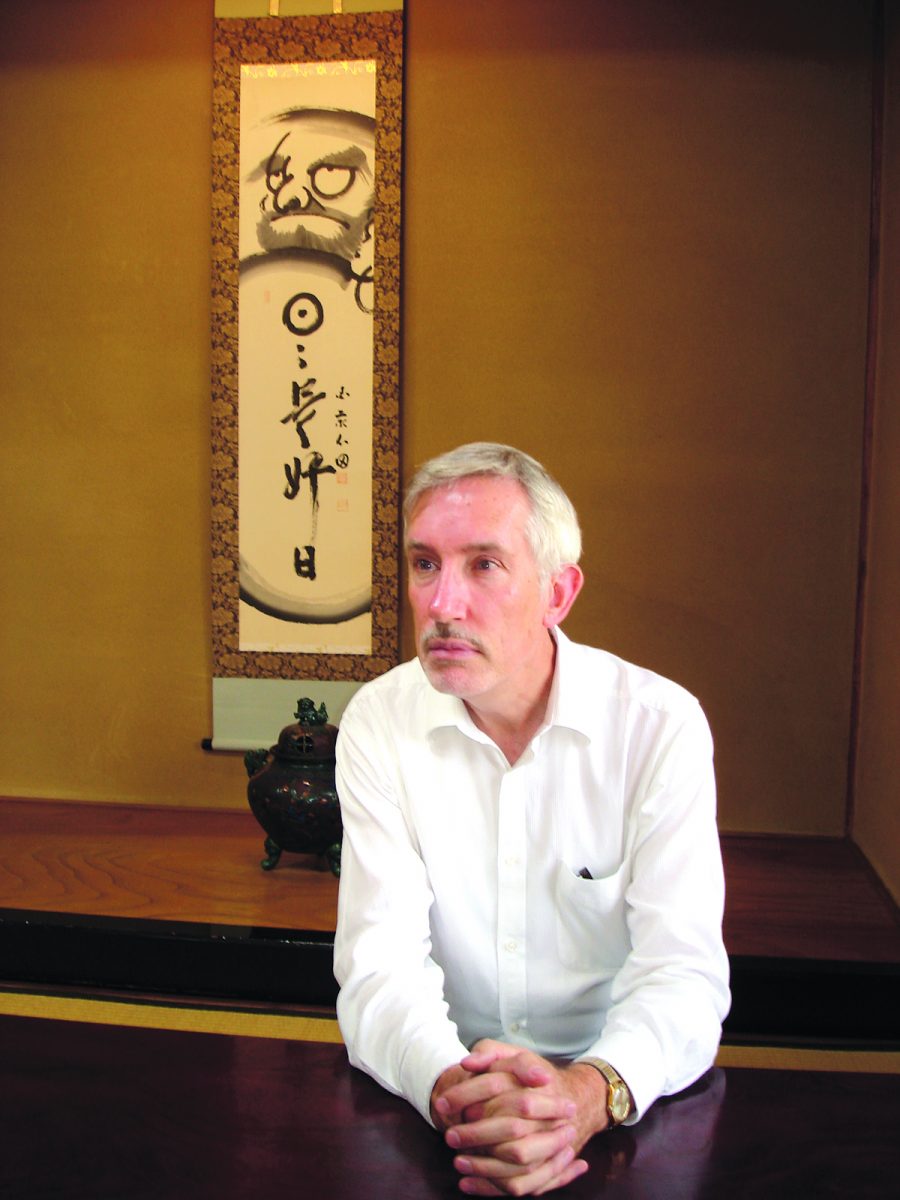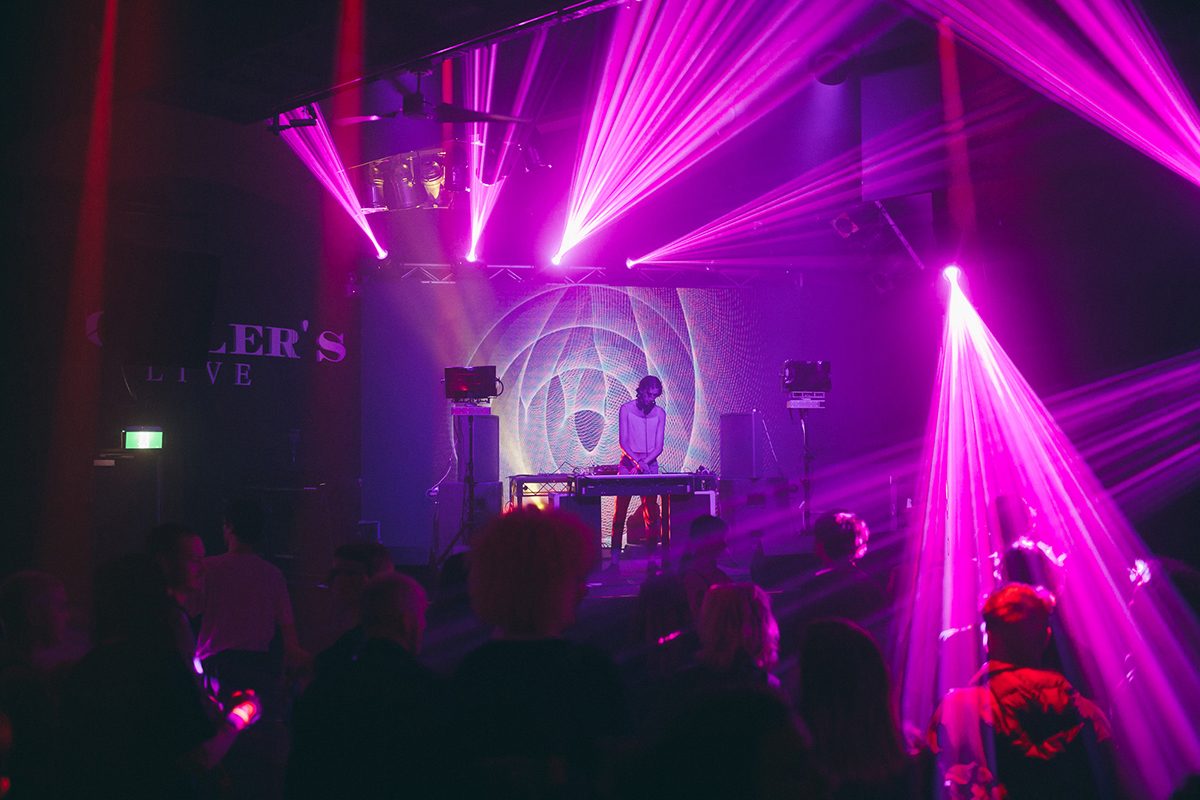July 2018
In this edition we look to the present that forges the future — the 2018 OzAsia Festival’s distinctive deepening of the relationship between Asia and Australia; and to the past — RealTime’s reporting of the challenges involved in cultural exchange in the visual arts as revealed in the second part of Katerina Sakkas’ intensive survey of visual arts writing in RealTime 1994-2004. Across 19 years of reviewing, Chris Reid tracks his personal responses to new music and its formal, technological and affective evolution. Finally, in these grim times, we bring you the first instalment of the best of the RealTime satirical sports columns of the 1990s, commencing with Tee Off with Vivienne Inch. Although, when Australian democracy is being perilously tested by the Government case against Witness K and his lawyer for allegedly threatening national security, we can only smile with gritted teeth. Keith & Virginia
–
Top image credit: War Sum Up, Hotel Pro Forma, artist image courtesy OzAsia 2018
This is Part 2 of a two-part look at RealTime’s visual arts coverage. Read Part 1 here.
In the second part of this overview of RealTime’s visual arts coverage during its first decade (1994-2004), I’m struck by how deeply the magazine’s writers engage with their material, keenly examining it from a range of angles. Here, they illuminate the complexities of cross-cultural exchange arising from new waves of contemporary Asian art; contextualise the millennial flourishing of photography, painting and video art; and bring linguistic playfulness to idiosyncratic installations.
For access to reviews in RealTimes 1-40 I’ve provided links to each edition and page numbers for you to scroll to. Reviews in editions 41 to 64 are directly linked.
Asia, Australia & cross-cultural complexities
A tendency towards glib globalisation is critiqued in several RealTime analyses of cross-cultural initiatives, particularly those involving Asian cultures.
“[T]o go beyond the simplistic essentialising of other cultures, a process of continual cultural contestation must take place,” writes Christopher Crouch in his report on the Symposium on Urban Dynamism in Asian Art, convened by the Art Gallery of WA to accompany the touring exhibition Contemporary Art in Asia: Traditions and Tensions [RT 24, p 43]. Crouch recounts the conference’s unintentional – yet fortuitous – demonstration of the ways in which cross-cultural negotiations fall down, resisting attempts to unify via a “coherent cultural structure that could encompass the different contexts of production and consumption of the works in the show.”
In “Tran’s Emporium opens up” [RT 28, p 29], Jo Law incorporates her own experiences as a Hong Kong-born Australian artist in an excellent overview of the problems underlying ‘multiculturalism’ as it manifests in marketing campaigns, cultural exchange programs, appropriative art-making and showcase exhibitions. In the pursuit of superficial feel-good results, too many factors that should be inherent to the process of cross-cultural collaboration are neglected:
“Doubtless, cross-cultural activities are invaluable in many ways, but it is important to establish a structure that will allow us to benefit from interacting and learning from different ways of life. The process of cross-cultural reading and practice needs to be more autonomous, more democratic and less institutionalised; independent initiatives should be welcomed and supported. Furthermore, the very notion of cultural exchange should be interrogated and this process should be a central objective in such activities.”
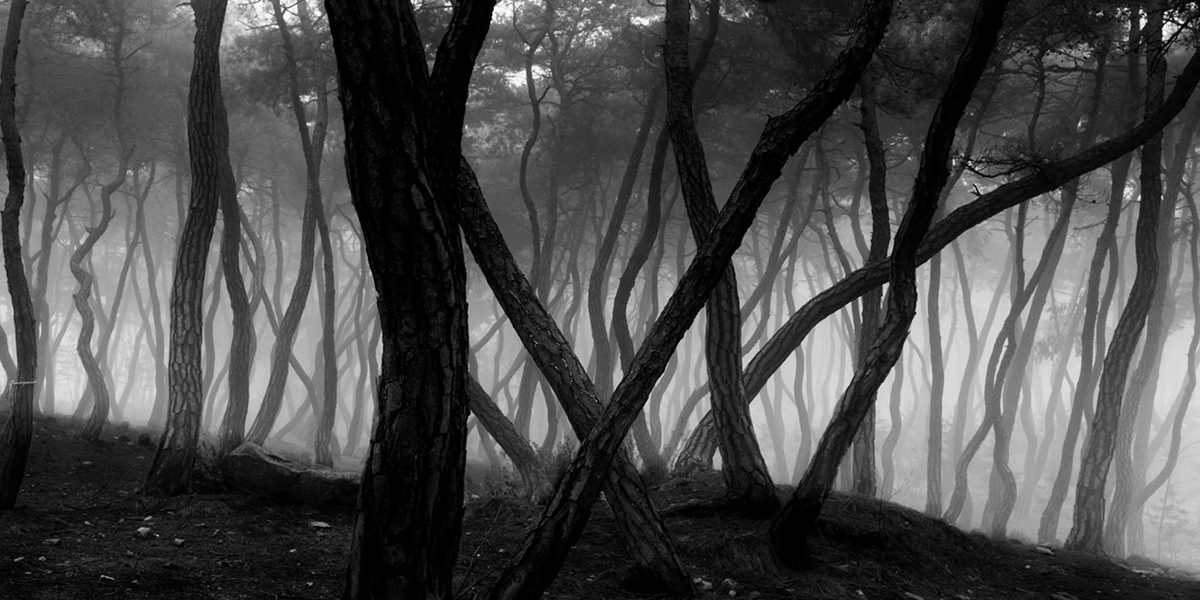
From Sonamu, series B 1992-97, Bae Bien-u, The Slowness of Speed – Contemporary Korean Art, National Gallery of Victoria, 1998
In her review of the exhibition of Korean contemporary art at the NGV, The Slowness of Speed [Cultural pace and individual acceleration, RT 30, p 42], Lara Travis notes, “It is a relief to visit an exhibition of contemporary Korean art and not be bombarded with rhetoric about cultural exchange and the diaspora, which has surrounded so many Asian art exhibitions and has, through overuse, acquired a diplomatic tone too expedient to be fully credible.”
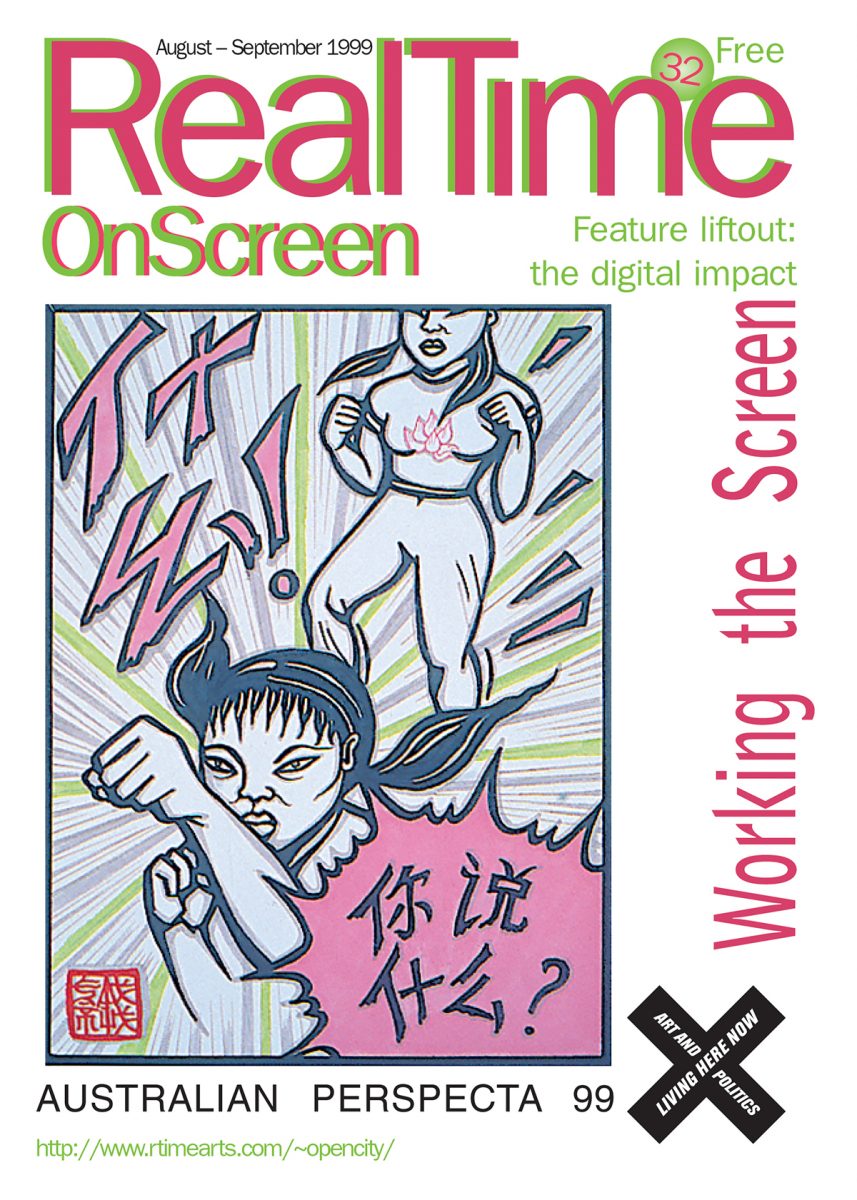
Li Ji Warrior Girl, Kate Beynon, 2000, courtesy the artist, Australian Perspecta 1999 featured on the cover of RT #32
On the same page, below Travis’ review, Hong Kong-born Australian artist Kate Beynon enacts a personal cross-cultural negotiation in a series of comics-style drawings of a pregnant action-heroine alter ego, depicted through a fusion of Chinese and Western iconography [Fluid significances, RT 30, p 42; see also cover image RT 32 above]. Reviewer Sandra Selig points out the simultaneous harmony and dissonance resulting from Beynon’s hybrid approach: “Beynon’s drawing finesse produces a seamless intersection of particular Eastern and Western graphic styles while retaining a stylistic incompatibility or difference.”
In late 2001, another artist embraces hybridity as a means of expressing his own cross-cultural identity and experience. In a vivid review, Anne Ooms [Filipino high kitsch with crab creole and politics, RT 45] evokes Perth-based Manila-born Alwin Raemillo’s enjoyable multi-sensory installation Semena Santa Cruxtations, showing at 24HR Art, Darwin, a lurid performative mashup of food, Catholic iconography, fast food advertising and Australiana that lampoons the Catholic Church and globalised business. In responding to Raemillo’s work, Ooms underlines the difficulty that attends this collision of cultures: “In the modern world radical differences are clustered together, constructing irresolvable contradictions. An ethics embracing cultural diversity becomes a necessity.” (Note the shift away from the use of “multiculturalism.”) She identifies Tropical Darwin as the perfect location for the exhibition, being “on the edge, where the complex and brutal consequences of colonisation are daily confronted and a migrant sensibility seems the norm.”
Djon Mundine in 2002 is inspired to write about VietPOP, an exhibition of seven young Vietnamese-Australian artists at Liverpool Regional Museum [VietPOP: a new generation speaks, RT50]. The exhibition tackles a number of intercultural issues, including the core refugee experience that nonetheless leads to a range of disparate relationships with homeland, adoption into white families, critiques of globalisation and the differences between these artists and their parents’ generation. International Vietnamese-Japanese art star Jun Nguyen Hatsushiba, included in the exhibition as mentor and counterpoint, provides other sources of cross-cultural conversation, by virtue of his dual heritage and the subtle ways in which his background differs from his fellow exhibitors. In his review Mundine broadens the conversation to include comparisons with Aboriginal communities.
Photography: analogue, digital & the natural
RealTime’s extensive coverage of photography reveals the way this multivalent medium came into its own in the 1990s, with its importance and centrality to contemporary art cemented by the 2000s. Large-scale surveys of the form were mounted at state galleries while pioneering contemporary Australian photomedia artists rose to prominence. RealTime writers examined photography’s mutable identity, its tendency to complicate the relationship between the natural and the artificial, the ethics of representation, and the gradual shift from analogue to digital technology.
Responding to The Power to Move: Aspects of Australian Photography, an exhibition of photographs from the Queensland Art Gallery collection [The death of (the) art (of) photography, RT 12, p 41], Peter Anderson traces the relatively recent trajectory of photography as an artform in Australia. Quoting from curator Anne Kirker’s catalogue, he notes that the period of active collecting of photography in Australia, dating back to the early 70s, coincides with “the period when photography became recognised as an artform appropriate to a culture searching for a democratic alternative to the traditionalism of painting and sculpture.”
Anderson finds diverse iterations of ‘art photography’ in the exhibition: archetypal Modernism as practised by Max Dupain, Olive Cotton et al; the photographer as artist/anthropologist, slipping into photo-journalism (Sue Ford, Micky Allan, Ponch Hawkes); and more conceptually-based work (Tracy Moffatt, Julie Rrap, Anne Zahalka). While the dialogue around the exhibition positions photography as new kid on the Australian art scene, Anderson posits that conceptual photography “has been at the leading edge of contemporary art practice in recent times, rather than at the margins.”
Writing about a symposium on the history of photography held at the Art Gallery of NSW in May 1998 [Shadow pictures, words of light, RT 26, p 46], Cassi Plate considers photography’s plurality of discourses: “…one of the organisers, Helen Grace, pointed out that at the last event of this kind in the 80s, photography was discussed strictly within art discourse and that now it clearly exceeded this ‘connoisseurship of art history,’ drawing instead on a richer mix of anthropology, media and cultural studies.”
Continuing this theme of photography’s multifariousness, in 2001 Mireille Juchau addressed two major photographic exhibitions in Sydney — Veronica’s Revenge: Contemporary Perspectives, at the MCA, and World Without End: Photography and the 20th Century at the Art Gallery of NSW [Veronica’s revenge and Judy’s dream, RT 43]. Here more than ever, the many guises of the medium are displayed, from the extravagant postmodern roleplaying of Cindy Sherman and Yasumasa Morimura to the explicit, intimate — yet contrasting — photo essays of Nan Goldin and Larry Clark. “Goldin’s work has all the tender empathy that Larry Clark’s Tulsa (1968-71) lacks in its frank sequence on heroin addiction.”
The transformation of photography by digital technology is touched on in 1997 and 1999 reviews by Jacqueline Millner of two exhibitions by Robyn Stacey, an Australian photomedia artist who “pioneered some important trends in the field” [Lush life, RT 17, p 34]. In the 1997 article [Artificial blooms, animated stills, RT 32, p 40], Millner highlights the blurring of the artificial and the natural in Stacey’s botanically themed exhibition, Blue Narcissus: “Stacey’s images are digitally manipulated, abstracted from the ‘natural’ to varying but unspecifiable degrees. While recognisable as flowers, these images may well have been entirely generated by a computer program (although we are told in Stacey’s program notes that many derive from the scanning of actual flowers). The animation of her creations by means of lenticular screens further complicates the distinction between the natural and the artificial, the living and the dead.”
The digital takeover of the medium is specifically tackled in Mitchell Whitelaw’s review of Tekhne, the August 2000 edition of Photofile magazine exploring the transition to digital technologies in contemporary Australian photomedia [Post-photographic Photofile, RT 41], while the impact of rapidly changing technology on Australian photomedia schools is examined in Mireille Juchau’s interviews with Australian curators and teachers in RealTime’s 2003 education feature [The adaptable, ethical artist-technician, RT 56].
The ethics and the psychological power of photographic representation comes into reviews of portrait and body-focused exhibitions. Virginia Baxter is both impressed and discomforted by Ella Dreyfus’ Age and Consent [RT 30, p 43], an exhibition focusing on the naked bodies of women in their 70s and above, some taken in aged-care facilities. And following a night viewing of historic crime scene photographs curated by Ross Gibson and Kate Richards at Sydney’s Police and Justice Museum, as well as having seen Denis del Favero’s large-scale installations titled Yugoslavian War Trilogy [Did we dream this? RT 34, p 32], Baxter and RealTime co-editor Keith Gallasch find certain images seared into their subconscious: “the photographs, in their simplicity and their immediacy, are scanned onto your wetware and over the coming days they’re impossible to delete. An uneasy feeling follows you about, like the day after you dream that perhaps you’ve murdered someone, that somehow you’ve been implicated…you are complicit.”
In her response to Telling Tales: the child in contemporary photography, a group show including work by Polixeni Papapetrou, Tracey Moffatt and Bill Henson among others [The child photographed, the child apart, RT 39, p 9], Zsuzsanna Soboslay picks up on the strange ambiguity that can result when children are captured behind the lens: “The camera, identified as anything from a tool of policing (Sontag, Foucault), to one of democracy (Bourdieu), is often laid open to accusations of veiling its interpretive manipulations under the guise of objectivity.”
Interfaces: painting and screen
Two significant trends in the early 2000s owed a debt to photography: the burgeoning of video art and the rise of postmodern figurative painting. Both movements were characterised by the influence of different media and the sense that the barriers between mediums were becoming less rigid and defining. As Darren Tofts noted in RT 63 [2004: unexpected innovations], “Screen-based media art and painting might not occupy the same physical space, but in 2004 they certainly occupy the same conceptual space, in conversation with, and informing, one another.”
In November 2000 [Against the wall: the art of Anne Wallace, RT 39, p 41], Maryanne Lynch interviews the painter about her somewhat lateral relationship to the precepts of figurative art and the very act of producing paintings, on the occasion of Wallace’s survey show at Brisbane City Gallery. Striving for the jewel-like colours of Hitchcock’s Vertigo and The Wizard of Oz, Wallace’s still, disquieting images draw heavily upon reference photos. Viewing oil painting as “the closest thing to a pure commodity these days and therefore totally kitsch,” she seeks to create “something that is almost like an alien infestation, an alien occupation, that takes over the painting.”
Interestingly, in 2002 both Maryanne Lynch and Anne Wallace appear together in a portmanteau exhibition at Brisbane’s Institute of Modern Art, also featuring mini-solo showings by Anne Zahalka and Annette Bezor [Film thematic at IMA, RT48]. Though the shows are ostensibly discrete, reviewer Barbara Bolt finds Lynch’s short film Pyjama Girl, in a nice example of the slippage between different art forms, “had escaped the confines of the projection room and implicated itself in the life of the other work.” Bolt recalls “Zahalka’s light box images of Sydney became more alienated and Wallace’s paintings attained a state of high anxiety.” She aligns Wallace’s work with film noir and sees in it an unfolding drama.
Painting flourishes within RT 42, beginning with pieces by Linda Jaivin [Liberating the artist from the revolution] and Trevor Hay [Sex, drugs and revolutionary ballet] on the Chinese counter-revolutionary Pop art explosion as exemplified in the work of Chinese-Australian painter Guo Jian. Further on, Chris Reid looks at Painting, the Arcane Technology [Reinvigorating the arcane], an exhibition of 12 Australian artists, whose curators Natalie King and Bala Starr note a resurgence of painting “after the 1990s infatuation with installation art, object-making, photography and multimedia practices.” The exhibition offers further evidence of cross-pollination of artforms, with the catalogue acknowledging “the influence of new media — cinema in the case of Wallace and Louise Hearman, photography in the case of David Jolly.”
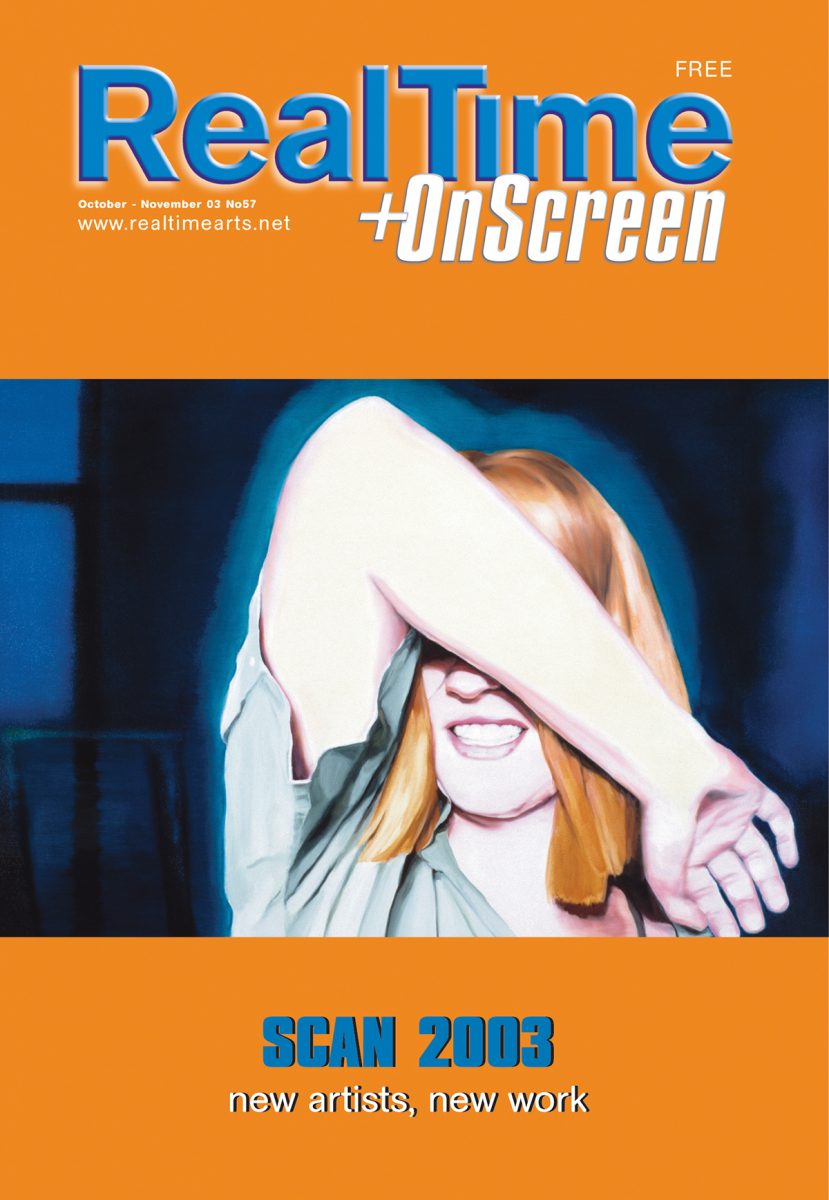
Lily Hibberd, Blinded by the Light, 2002, reproduced on the cover of RealTime #57 courtesy of the artist, Art+Film exhibition, Centre for Contemporary Photography, Melbourne
To round off the painting/screen culture nexus, the paintings of Lily Hibberd are singled out by Daniel Edwards in a review of the multidisciplinary exhibition Art + Film at the Centre for Contemporary Photography (CCP), examining cinema’s infiltration of contemporary Australian art [The art of in-between, RT 57]. “The oil and phosphorescent paintings captured the hypnotic illumination of the cinema screen, as well as cinema’s reliance on the ephemeral qualities of light to bring its images to life. More crucially, at the level of form and content, these two paintings illustrated the concerns running throughout Art + Film.”
Video art rising: the body, the everyday
RealTime’s documentation of a decade of flourishing video art evidences a form every bit as diverse as photography, ranging from grainy anti-aesthetic VCR pieces to the grandiose visions of Bill Viola and Lyndal Jones. In 2003 [Video goes big time: some crucial questions, RT 56], Blair French provides a terrific overview of the form, from its roots in experimental film to the great scope and variety of contemporary practices, and usefully wonders what critical approaches are best equipped to deal with such formal and conceptual diversity – something further complicated by video’s ubiquity outside of the art world. It’s a great reference for anyone seeking to grapple with what precisely constitutes video art.
In 1999, Edward Scheer is impressed by the power of work by four major women video artists in The 5th Guinness Contemporary Art Project, Voiceovers, at the Art Gallery of NSW [One day all headstones will be electronic, RT 34, p 13]. Works by Nalini Malani, Shirin Neshat, Mariko Mori and Lin Li produce an empathetic response that signals video’s potential to “effect the rescue of our tired media and our exhausted senses and re-humanise aesthetics as an experience of the body.”
Bec Dean’s experience of Bill Viola’s installation The Messenger, viewed on this occasion at St George’s Cathedral, and The Interval, at John Curtin Gallery – both part of the 2000 Perth International Arts Festival – is of immersive work that knowingly deploys Renaissance pictorial conventions and the symbolism of religious architecture to “force the body into feeling” [Perth Festival: breaking surfaces, RT 36, p 7]. An interview with Lyndal Jones on her work Aqua Profunda, representing Australia at the Venice Biennale [Aqua Profunda: art in the deep end, RT 43], reveals a similar desire to immerse the viewer: “I work with video from a subjective, experiential position for the viewer. Consequently, a certain type of critic has difficulty with it because they can’t stand outside it and analyse it. But for a lot of people just watching it, it’s quite straightforward. They’re just in it.”
At CCP’s installation of David Rosetzky’s standardised set of video confessionals playing with both banality and intimacy, Ned Rossiter is another RT writer prompted to assess the emotive power of video art [Custom made confessions at CCP, RT 38, p 35]. The simultaneous artifice and directness of Rosetzky’s work raises a question about what factors make a filmed confessional credible. Undercut by the instability of their display (fleeting projections on cheap wood veneer), the earnest monologues suggest “our sense of reality is constituted precisely in the refigurings we make of mediatised commercial culture.”
Writing in 2004 about video works “bridging the worlds of art and daily life” [Video, medium of the moment, RT 62], Rachel Kent unequivocally positions video bang in the centre of Australian contemporary art practice after a decade of significant employment – a decade that fortuitously coincides with RealTime’s own first 10 years. She considers two Sydney exhibitions: Mix-Ed: diverse practice and geography, at Sherman Galleries, and Interlace at The Performance Space. In Mix-Ed, she finds emerging Australian video artists (Emil Goh, Shaun Gladwell, Daniel Crooks, Daniel von Sturmer) making a kind of poetry from the everyday, urban environment, and in Interlace (featuring Goh, Gladwell and Kate Murphy), the “role of performance in daily life is a recurrent theme.”.
Kent also mentions video’s propensity to absorb other artforms: “Drawing upon conventions of documentary and portraiture, and referencing art history as much as cinema and pop culture, [these works] bring the city and its inhabitants to life in often unexpected ways.”
The art experience captured in words
As I wind up this overview, having looked at broader trends and scholarly surveys, it would be remiss not to mention RealTime’s attention over the first decade to small, off-beat exhibitions, which it approached through a range of personal, equally idiosyncratic responses.
Virginia Baxter’s reviews are characterised by an elegant, experiential quality that’s wittily evocative. Her 1997 [RT 19, p 14] response to Incognito, an exhibition of women installation artists, is a sort of dance through the Performance Space Gallery, tracking the movement of her body, eyes, feet as she’s alternately drawn to one work before being distracted by another. “Suddenly someone else enters the room. Caught screen hogging, I scramble up from the floor. Is that the time? Easily an hour has passed. I scuttle backwards through the exhibition, nodding to the coloured messages, still pulsing a pink ‘Don’t’. Darting a parting glance at the still jumping girl with the fans, hair flying, I fall into the street.” The experience is indivisible from the artwork, and the review is richer for it.
Linda Marie Walker’s elaborations on Rick Martin’s Maria Ghost [RT 23, p 31] and Jonathan Dady’s Construction Drawings at CACSA [So close to the thing itself, and not], are little artworks in themselves; text-based analogues of the original installations. Her meditation on drawing in the latter review could apply equally to her reviewing: “Is drawing an after-effect in its own right? Does a drawing make its subject (overall) a completely different thing (?) — a thinking thought-of thing, a point of transition, from which it desires to be the effect of ‘afterwards’; after-the-fact of presence comes another presence (over and over) from which the thing cannot recover, it’s there ‘anew’, however slight the change might be —perhaps changed only by acts of thought.”
In a similarly inventive way, Russell Smith approaches Shaun Kirby’s installation Gasfitter [RT 39, p 43] as a list of clues through which one might decode the artist’s “minimal”, “signlike” objects. “Like words they’re empty, arbitrary, and meaningless as things-in-themselves, intelligible only through their relationships. But rather than the jokey challenge of the riddle, Kirby’s is the creepy syntax of the enigma.”
Demonstrating the stylistic possibilities of arts writing, these lively snapshots join RealTime’s bigger-picture analyses to form a considerable breadth of visual arts coverage, affording readers the opportunity to delve deeply, gaining an insight into movements, mediums and makers; and a vivid sense of the cultural landscape of the time.
–
RealTime Assistant Editor Katerina Sakkas is a Sydney-based writer and visual artist. You can read about her here.
Top image credit: Springtime, 1999, Anne Wallace, courtesy the artist
Partway through my interview with Joseph Mitchell, now overseeing his fourth OzAsia Festival as Artistic Director, I observe that more and more dance, theatre and cross-artform work from Asia is being programmed by Australian festivals and flagship companies, often off the back of seasons at OzAsia. He seems genuinely pleased. “I’m glad you noticed that, Ben,” he says in his briskly efficient but always impassioned manner, “I really appreciate it.”
Since Mitchell took over from Jacinta Thompson as OzAsia Artistic Director in 2015, the landscape for Asian performance in Australia has undergone significant change. Before OzAsia, the only major celebration in Australia of Asian art was Brisbane’s Asia-Pacific Triennial, commenced in 1993 and principally a large-scale visual art exhibition but also including cultural performance and performance art. Commencing in 2007 and once the country’s sole festival focused principally on Asian performance, OzAsia now rubs shoulders with Melbourne’s Asia TOPA Triennial of Performing Arts, first staged in 2017, and, in Sydney, Performance Space’s annual Liveworks Festival. Meanwhile, organisations such as Contemporary Asian Australian Performance (CAAP, formerly Performance 4a) and Playwriting Australia, through its multi-year Lotus initiative, are fostering a new generation of Asian-Australian artists like Michelle Law and Katrina Irawati Graham.
This year’s OzAsia will be held a month later than usual but there’s an early program announcement to whet the appetite: three Australian premieres in dance, theatre and opera spanning South Korea, Japan and China, plus two major contemporary art exhibitions at the Adelaide Festival Centre and Art Gallery of South Australia. For the first time, the festival will also host the Jaipur Literature Festival, a South-Asian institution and purportedly the largest free literary festival in the world. The works announced so far attest to Mitchell’s adventurous programming and commitment to representing the formal and conceptual breadth of contemporary Asian performance. He explains that, unlike in previous years in which a geographical focus shaped his programming decisions, 2018’s festival has been more broadly conceived to showcase the global influence of Asia and its diasporas.
“In my first festival,” Mitchell tells me, “we had a country focus on Indonesia but for the last two I’ve tried to veer away from specific identities because I really think our message is solely that we’re a festival celebrating contemporary arts from across Asia. So this year our program, which we’ll release in about four weeks, is very broad. We’ve got work from East Asia, South Asia, South-East Asia and across the Middle East and the Arab world as well. So we’re looking at a broad continental perspective as well as works that are borderless or come from other regions of the world but that are driven or inspired by, or in some way taking consideration of, the impact of contemporary Asian art.”
Eun-Me Ahn, Dancing Grandmothers
I begin by asking Mitchell about Dancing Grandmothers by prolific South Korean choreographer Eun-Me Ahn. Watching clips online, I’m put in mind of other contemporary dance theatre works by the likes of Jérôme Bel (2015’s Gala) and 600 Highwaymen (2013’s The Record) that foreground and celebrate non-professional and mixed-ability performers. “Dancing Grandmothers definitely continues that narrative,” agrees Mitchell. “Eun-Me Ahn asked herself, how do I create an ode to the women who founded Korea? So she jumped in a car with a video camera and drove all around South Korea trying to capture a sense of how South Korean women express themselves through their bodies. She took that footage back to her company of 10 dancers who created a response to it, which forms the first part of the work — a fun, frantic 45-minute sequence on its own. But then you are shown some of the footage Eun-Me Ahn took and you see the grandmothers dancing in their small villages and the like.
“After that, the 10 grandmothers” — Mitchell explains that the group changes every time the show goes on tour — “and the 10 company dancers come out on stage and the 20 of them all dance together, fuelled by disco-inspired Western-Korean pop music. It’s a really quirky series of songs with crazy lights and projections, which reflects Eun-Me Ahn’s personality, but also the vibrancy and energy of these women. Finally, the audience is invited up on stage, and the work becomes a huge disco rave with the grandmothers in the middle of it all. The work is a wonderful celebration of these women, most of whom have never before had the chance to leave Korea and explore the globe.”
Hotel Pro Forma, War Sum Up
In addition to dance, this year’s program also continues Mitchell’s interest in presenting contemporary Asian opera via War Sum Up, a 75-minute electronic opera directed by the renowned Kirsten Dehlholm from Denmark-based company Hotel Pro Forma. Mitchell describes the work as a “powerful, short, sharp, visually striking and musically robust 21st century opera.” He explains, “It forms part of a bigger framework we kick-started last year (with Japanese composer Keiichiro Shibuya’s ‘vocaloid’ opera The End), where we’re thinking about opera not in the context of the traditional Chinese canon but from a global 21st century contemporary perspective. War Sum Up,” Mitchell continues, “is a good example of what I was saying before about moving beyond a geographical definition of Asia and thinking more about what is the influence of Asian contemporary culture globally in the 21st century. With this work, you’ve got a Danish director, a Latvian choir, Japanese Manga for the design, and the libretto, sung in Japanese, is based on traditional Noh texts.
“As a piece of staging,” Mitchell says, “it’s highly visual and the musical range is extremely dynamic. While it’s an opera, there’s no live orchestra, it’s all electronic music, and the actors have microphones, which are used for all kinds of effects and distortion. It’s a work that really pushes against and blurs the boundaries of opera as a form, one that should continue to be rethought and experimented with.”
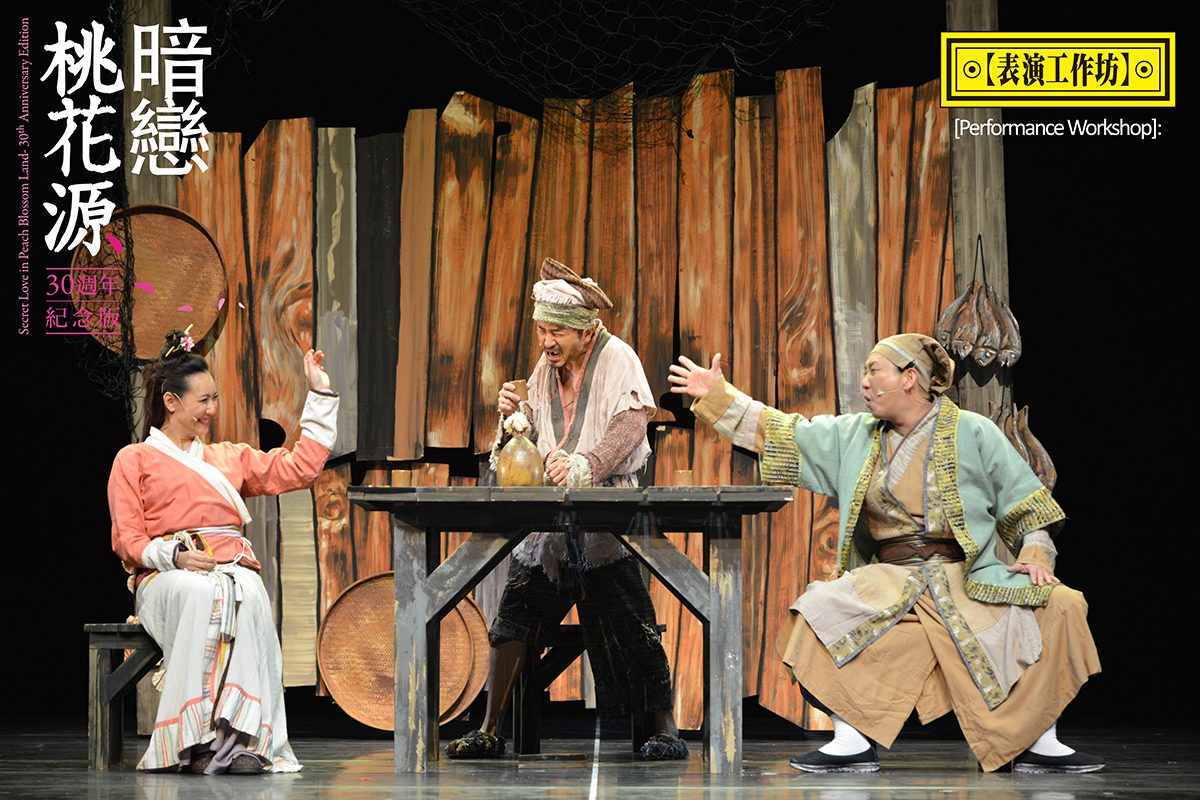
Promotional image, Secret Love in Peach Blossom Land, Stan Lai and the Performance Workshop, image courtesy OzAsia 2018
Stan Lai, Secret Love in Peach Blossom Land
Relative to War Sum Up, Chinese playwright and director Stan Lai’s Secret Love in Peach Blossom Land looks decidedly traditionalist. 30 years old, the Mandarin-language play is now widely considered a canonical work of contemporary Chinese theatre (though it has not been seen in Australia before). “Stan Lai,” Mitchell tells me, “is a household name in China, much as someone like Baz Luhrmann is here, but for 1.2 billion people. And Secret Love is really the show that broke him and his long career trajectory when it was first staged in 1987.” Not unlike Michael Frayn’s 1982 play Noises Off —Mitchell endorses the comparison — Secret Love is a meta-theatrical comedy about two theatre companies booked by mistake into the same rehearsal space.
“What’s fascinating is that it’s surprisingly fresh and modern,” Mitchell says, “because it’s got a whole meta-theatre narrative running through it, a trend that Lai was way ahead of in my opinion. Part of the reason it looks a little bit traditional,” Mitchell explains, “is because you’re watching two companies stage very traditional shows. You end up watching three plays. One is a kind of memory play where the director is staging something that seems quite biographical around lost love and separation as a result of the Chinese Revolution. On the other hand, there’s a group of young actors, probably not far off graduating from university, who have found an old Chinese text and they’ve decided to reinterpret it as a farce with clowning and sexual innuendo. So, as these troupes try to navigate sharing the rehearsal space, you see their respective plays in the making but also see the backstage circumstances, which include the stage and theatre crews figuring out how to settle their tensions as opening night gets closer and everyone becomes more and more stressed. While it’s farcical, it’s also quite moving and resonant because it touches on themes such as family separation and displacement across borders.”
Visual arts: Ryoji Ikeda and Chiharu Shiota
Mitchell is also promising a strong visual arts program this year, tantalisingly hinting at “some very strong links sitting across the various solo exhibitions so that audiences who love the visual arts will be able to look at a bigger emerging thematic picture.” Announced so far are solo exhibitions by two Japanese artists known for their large-scale installations, Ryoji Ikeda — making a welcome return to OzAsia after presenting the intriguing Superposition in 2015 — and Chiharu Shiota, from whom the Art Gallery of South Australia has commissioned a new work, to be exhibited alongside what Mitchell describes as “the first major retrospective of her work.” Ikeda’s data.tron, part of his datamatics series that renders raw data in spectacular 2- and 3D computer-generated patterns, will take up an entire wall of the Adelaide Festival Centre’s Artspace gallery. Shiota’s newly commissioned work, Mitchell explains, will “disrupt one of AGSA’s existing galleries and works by being a significant installation that traverses through the space and around other works in very unexpected ways. It will be very exciting.”
The overall scale of the festival promises to be impressive, reflected in the diversity and richness of work on offer — much of it boundary-pushing or engaged in revitalising conversation with inherited forms. “We’ve got 57 events this year,” Mitchell tells me, “Last year was 50, so it’s our biggest festival yet. 798 artists are coming.” There’s the prospect of another show being “squeezed into the program at the last minute, which I’m quite happy about because it means we’ll end up having over 800 artists. I think we’re in a really good place, particularly with the addition of the Jaipur Literature Festival, which ensures that literature becomes a more significant part of the program.”
While Joseph Mitchell anticipates a more robust conversation about the integration of Asian arts and culture in the Australian mainstream — a grappling with “the multicultural diversity of this country and the place of Australia geographically at the southern tip of Asia” — the OzAsia Festival, under his venturesome direction, continues to point the way forwards.
–
OzAsia Festival 2018, Adelaide Festival Centre, 24 Oct-11 Nov
Top image credit: Eun-Me Ahn’s Dancing Grandmothers, photo Eunji Park
Great composers, transcendental music
Nineteen years ago, I heard Adelaide pianist, lecturer, critic and composer Stephen Whittington perform Morton Feldman’s For Bunita Marcus (1985), a work for solo piano of over an hour that takes you into another realm of musical and meditative experience. “Sounds do not commence but seem always to have existed…”, I wrote. “Awareness is heightened. The paradoxical notion of infinity in a moment is understood, even attained” [RT 32, p43]. For Bunita Marcus is gentle yet absorbing music, as is Feldman’s Triadic Memories [RT85] which Whittington performed nine years later at the only ever Melbourne International Biennial of Experimental Music, curated by the redoubtable duo of Anthony Pateras and Robin Fox.
Whittington’s performance of For Bunita Marcus changed my life by changing the way I listen. Feldman’s unique and wondrous music is a constellation that illuminates the night sky, and together with the keyboard music of Schubert, Beethoven, Liszt, Chopin, Shostakovich and of course the galaxy’s hub, Bach, Feldman’s music helps me navigate both the musical world and my own soul. There have been revolutionary compositional and technical developments in music throughout the 20th century, many of which I have been privileged to write about for Real Time, but the music that so often turns me into a rabbit-in-the-headlights is music for the solitary pianist — a high priest/ess who sits alone at the 88-note portal to the composer’s universe. I never learnt the piano, nor any other instrument. Wish I had.
Whittington has been a champion of all kinds of contemporary music and is a pivotal figure in the Adelaide scene, bringing us many delights besides Feldman, for example his John Cage Day [RT111], his homage to experimental film-maker Stan Brakhage [RT102], and his performances of the music of Georgy Kurtag (RT40, p35), Erik Satie and other eccentric innovators. “Whittington’s solo performances typically take the audience, and himself, on a journey… Often, both performer and audience enter what Whittington suggests is ‘a certain mental space—you become attuned to a certain state to experience something unusual’” [RT111].
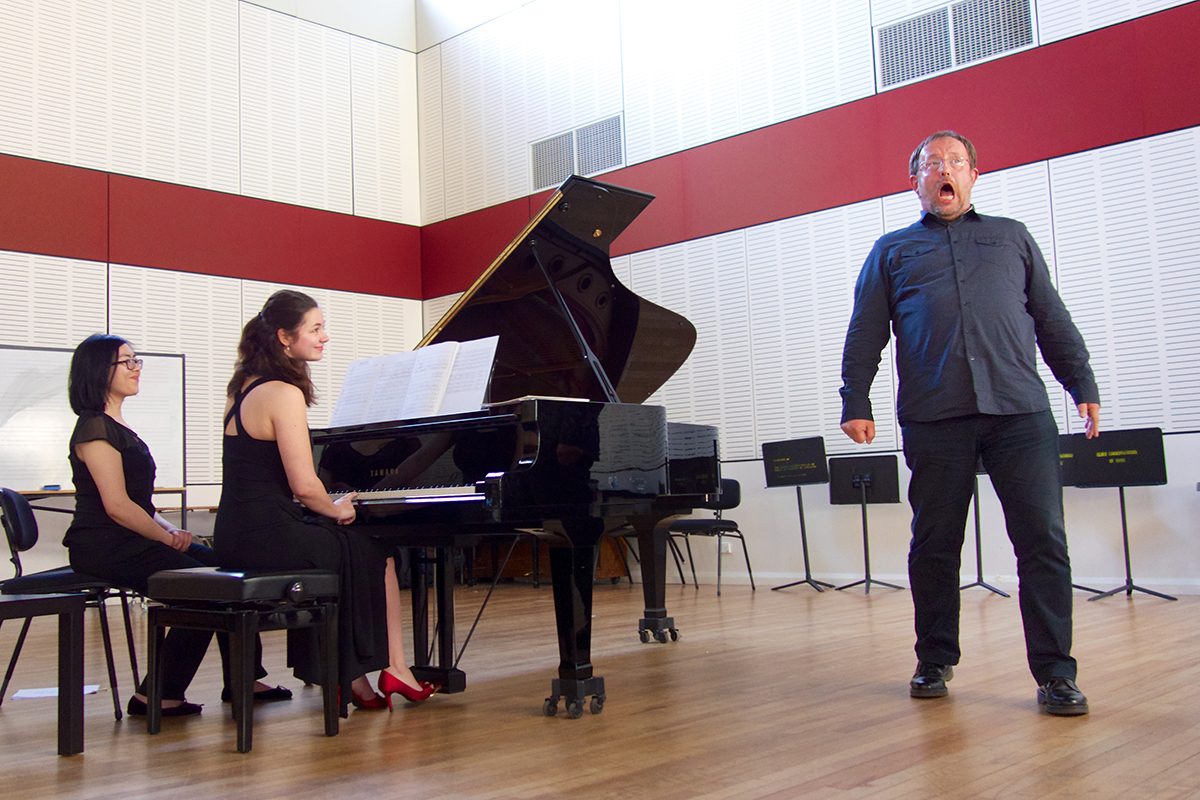
Daniel Matej and pianist Marianna Grynchuk, Daniel Matej in Perspective, Soundstream 2012, photo Keith Halden
Soundstream Ensemble’s Artistic Director, pianist Gabriella Smart [RT106], has also introduced audiences to some wonderful music by little-known modern composers through performances by the Ensemble [RT52] and through her Adelaide New Music Festivals of 2008, 2009, 2010 and 2012 [RT99], which brought much new music to Adelaide, for example the Spectralists [RT52], Sofia Gubaidulina and Hanna Kulenty [RT93] and Daniel Matej [RT112]. Smart curates programs of wonderful but rarely heard music that provide great insights into the evolution of composition and performance. Most importantly, Soundstream regularly commissions new work, and commissioning is vital to fostering development.
Smart undertook her own herculean solo piano performance in realising Alvin Curran’s five-hour work Inner Cities in 2013. “In rendering his own lifetime as composition, Alvin Curran shows how composition is inevitably an extension and exploration of personal experience” [RT 117].
Pateras, Smart, prepared pianos, unprepared listeners
In Melbourne composer and performer Anthony Pateras’ various performances, I’ve been seduced by a very different form of pianism. John Cage brought the prepared piano gently to prominence but Pateras’ elaborate piano preparations coupled with his high-energy approach elevate solo piano music to theatrical drama in his Continuums and Chasms (2005-6). In RT 76 I wrote, “Pateras’ modifications generate rather claustrophobic sonorities—the whole top octave of strings is heavily gaffer-taped to make a sound like closely miked marbles cascading onto a concrete slab. In the lower registers, Pateras employs the usual bolts and screws and also cardboard wedges and other soft material to damp the strings, producing overall the sound of a percussion orchestra.”
At MOFO in 2017, Pateras played an old upright piano with the front removed in an improvised performance with Erkki Veltheim (amplified violin) and Scott Tinkler (trumpet). Such was the ferocity of Pateras’s playing that he broke three piano hammers which went flying over his shoulder towards the open-mouthed audience standing behind him. Afterwards Tinkler photographed the hammers as they lay on the floor — a musical moment to remember.
Gabriella Smart has gone so far as to remove the frame from an old, disintegrating upright piano and play the strings with her hands and with mallets in several performances in her Unpiano series of group improvisations in 2017. In these performances, Smart also performs on prepared piano and keyboard synthesiser. The trio of Smart, together with visiting German performance artist Johannes Sistermanns, who generates resonances from the auditorium walls, the piano soundboard and other vibrating surfaces using iPad-controlled transducers, and saxophonist Derek Pascoe, might seem an unlikely grouping, but such music and such instrumental combinations no longer seem as far-fetched as they did 25 years ago.
Smart’s performance on the trashed piano frame isn’t only about capturing the fragile sound that rusty, out-of-tune piano wires make, it is about foregrounding the iconic status of the piano and its place in the history of western music since the 18th Century. The piano’s gutting is symbolic, and its innards are ceremonially probed like a saint’s vital organs removed from their reliquary. Conceptually, as well as musically, the Unpiano concerts were deeply involving.
Electronics: possibilities, more icon-busting & the apotheosis of the mixer
Over the last 25 years, the use of electronics, pioneered in the 1960s by the likes of Karlheinz Stockhausen, Delia Derbyshire, Daphne Oram and Tristram Cary, has become commonplace in all sorts of manifestations, such as pre-recorded and synthesised sounds, live sampling, combinations of electronic and acoustic instruments and spatialisation of the sound through multi-speaker arrays to create immersive experiences. Live performance has been transformed forever with the introduction of the laptop, which can be used alone or in partnership with other devices and instruments. Musicians using acoustic instruments have replaced the paper manuscripts on their music stands with iPads. And they might wear earbuds to hear click-tracks, dispensing with conductors.
The use of electronics to mediate the sound of an acoustic instrument has been pushed to extreme levels. At Tectonics in the 2016 Adelaide Festival of Arts, “The evening closed with legendary US minimalist composer Phill Niblock’s dramatic work Vlada [RT 131], performed by Eyvind Kang on viola with electronics. The sound gradually built polyphonically until it reached the proportions of a cathedral organ with all stops out, saturating us with harmonics and microtones.”
Speak Percussion’s Glass Percussion Project, in which two percussionists played on a vast array of glass instruments inside the wall cavity of Melbourne’s Federation Square atrium, was also highly conceptual and involved visual art and craft, the exploration of the architecture and electronic manipulation. “The sound the audience hears is at times heavily mediated through Myles Mumford’s live processing. The computer processor is an essential component of the instrumentation, and the performers are cued through click tracks to coordinate their playing with the processing. In effect, two people—the performer at the glasswork and the performer at the computer—are playing some of these instruments” [RT83].
In Mimic Mass’s performance of Split Radio at Conical Gallery in Melbourne in 2007, three singers each covered a sequence of well-known pop songs, all three singing different sequences simultaneously, so the experience was like listening to three radios tuned to different stations. You could listen to all three at once or to one or other individual through headphones. The voices were transmitted to a PA in a smaller room via a mixing desk through which the voices were morphed, fragments repeated and effects such as drum and bass accompaniment were added. “To transmit is to transmute,” I suggested in RT 78.
The mixer has long become a performer, and the re-conception of the mixer’s role has been enabled and encouraged by technological innovation.
Music as conceptual art — think while you listen
Electronic mediation shifts the performance into another realm of experience and ideas — music as conceptual art. “Mimic Mass’s Split Radio could be described as a performance-installation involving the rendition and electronic mediation of iconic musical and textual material within an overarching compositional structure that unfolds exponentially and that requires the listener to be a mobile, active interpreter. It references DJ-ing that melds musical fragments into a new whole, and mimics the cultural and mental saturation of contemporary life. It breaks the spell of pop music, offering an alternative, oblique aesthetic. It’s iconoclastic and demanding but ultimately it’s a fun event.”
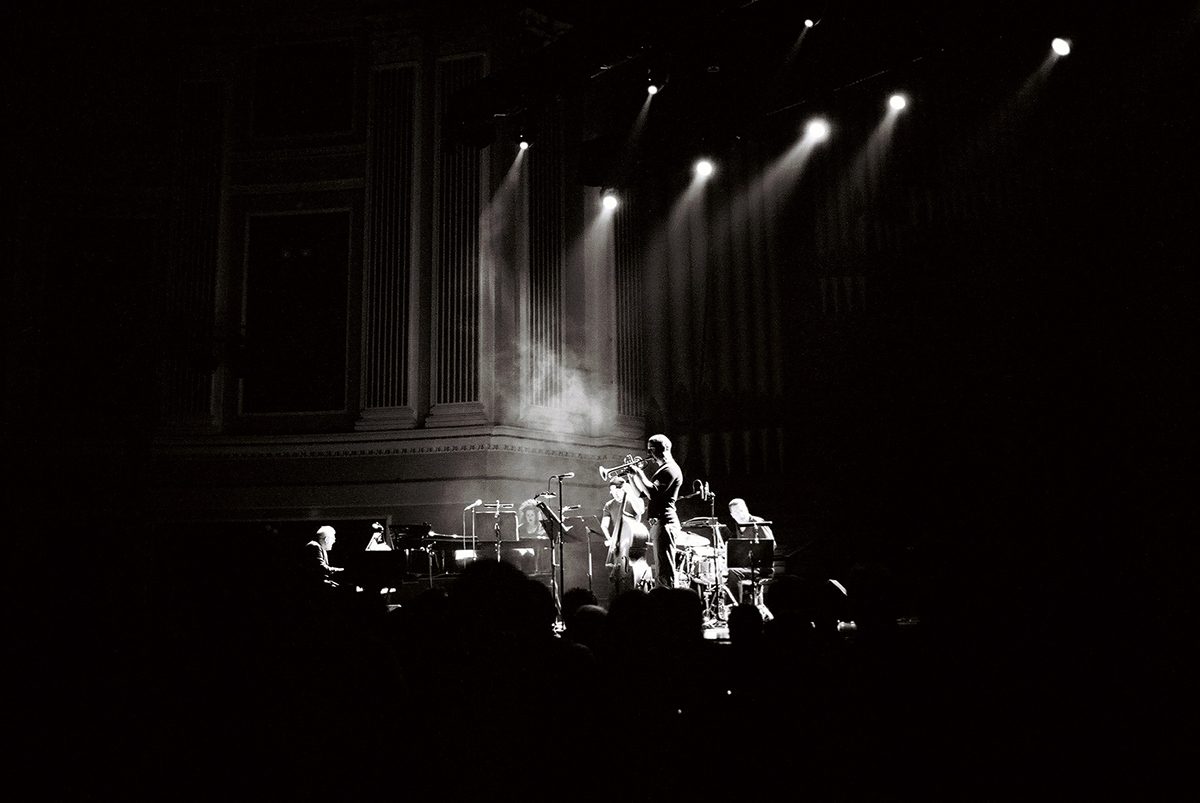
Australian Art Orchestra, Miles Davis: Prince of Darkness, photo courtesy Adelaide Festival of the Arts, 2012
Perhaps the most overwhelming musical performance I have experienced was the Australian Art Orchestra’s Miles Davis Prince of Darkness concert in the 2012 Adelaide Festival of Arts. The concert’s second half featured Anthony Pateras’s composition Ontetradecagon. “Knowing that Davis’ late work, particularly his On the Corner album (1972) was influenced by Karlheinz Stockhausen, Pateras pays homage to the experimentalism of both Davis and Stockhausen by exploring the conjunction of jazz improvisation and experimental music. AAO members were located in six groups around the auditorium — on stage, on either side, at the back and on the balcony — with Pateras strategically positioning himself in the centre aisle facing the stage. Pateras uses a Revox B77 to replay fragments of On the Corner and process elements of the live performance, while the AAO play from Pateras’ score which is orchestrated from On the Corner pitch elements and structured to allow improvisation. The spatialisation immerses the listener — I felt as if I were inside Davis’ and Stockhausen’s minds simultaneously” [RT 109].
Ontetradecagon was a consummate performance of great music by a great composer, Pateras, and great performers, the AAO. I was catapulted into an exponentially enlarged sonic, conceptual and compositional universe. I couldn’t have absorbed this music or appreciated its significance without the benefit of my expanded ears — you can’t navigate this universe just by sighting the old constellations.
Human or inhuman music?
The synthesiser itself has been developed way beyond anything Stockhausen & Co might have wished for, as was evident at MOFO 2017: “The cutting edge of technical development in the field of electronic music currently seems to be Guy Ben-Ary’s cellF described as the world’s first neural synthesiser, which he developed in cooperation with a team of scientists, technicians and musicians. CellF comprises a small ‘brain’ —biological neural networks grown from Ben-Ary’s own stem cells in a Petri dish — that controls a series of analogue modular synthesisers. It functions autonomously and can perform solo or with other musicians to whom it responds” [RT 137].
Could an android perform? In the 2017 OzAsia Festival, composer-pianist Keiichiro Shibuya performed with a singing android named Skeleton and the Australian Art Orchestra. “Skeleton’s voice suggests some human characteristics…The android’s actions are driven by algorithms based on emergence theory and chaos theory giving it control over its limbs and facial expressions. Electronic sensors detect and process the pitch and amplitude of ambient sound, light and movement to generate autonomous and very realistic gestures and expressions.”
At a seminar during the OzAsia Festival, Skeleton’s Japanese designers considered whether “an android [could] go beyond autonomous physical and facial expression and develop emotional sensitivity, empathise with humans, demonstrate artistic ability and perhaps coexist with humans on equal terms? In short, could androids replace humans in a post-Anthropocene world?”
The audience — how to be a musician without really trying
The relationship between the traditionally passive audience and active performer has evolved into a partnership. Zephyr Quartet, another of Adelaide’s new music champions, experimented with direct involvement of the audience in their 2014 concert Music for Strings and iThings, which followed logically on the near universal uptake of that revolutionary device, the smart phone. They invited audience members to download and play loudly over their phones fragments of pre-recorded music to accompany the Quartet’s playing.
The concert encapsulated many emergent strategies for music-making: “Zephyr’s relentless quest for musical and compositional originality and their work with diverse collaborators continues to position them at the forefront of innovation, involving in this concert appropriation, field recording, live processing, pre-processed sound, visual art, aleatoric elements and directed and spontaneous audience participation. The concert is perhaps a wry commentary on the way in which new technologies have invaded our lives and come to dominate communication and thought processes, but it also demonstrates the way in which contemporary culture can condense so many sonic, musical and cultural traditions and ideas into a new paradigm” [RT125].
Education — training musicians in an electronic world
For her Honours project in Sonic Arts at the University of Adelaide in 2015, composer, musician and sound engineer Iran Sanadzadeh revived and extended the work of Australian dancer Philippa Cullen, who, in the early 1970s, began experimenting with theremins to produce sound through dance movement. Sanadzadeh’s If/Then is an improvised work for several performers who dance on movement-sensitive panels to trigger shifts in pitch in a theremin-like drone that runs throughout the performance. Her work is, “about exploring a range of possible actions with indeterminate outcomes, suggesting the influence of John Cage. And as well as demonstrating and extending Cullen’s original idea of reversing the relationship between movement and sound, Sanadzadeh’s concept also inevitably speaks of the new era of electronic surveillance and prosthetic technology” [RT 129].
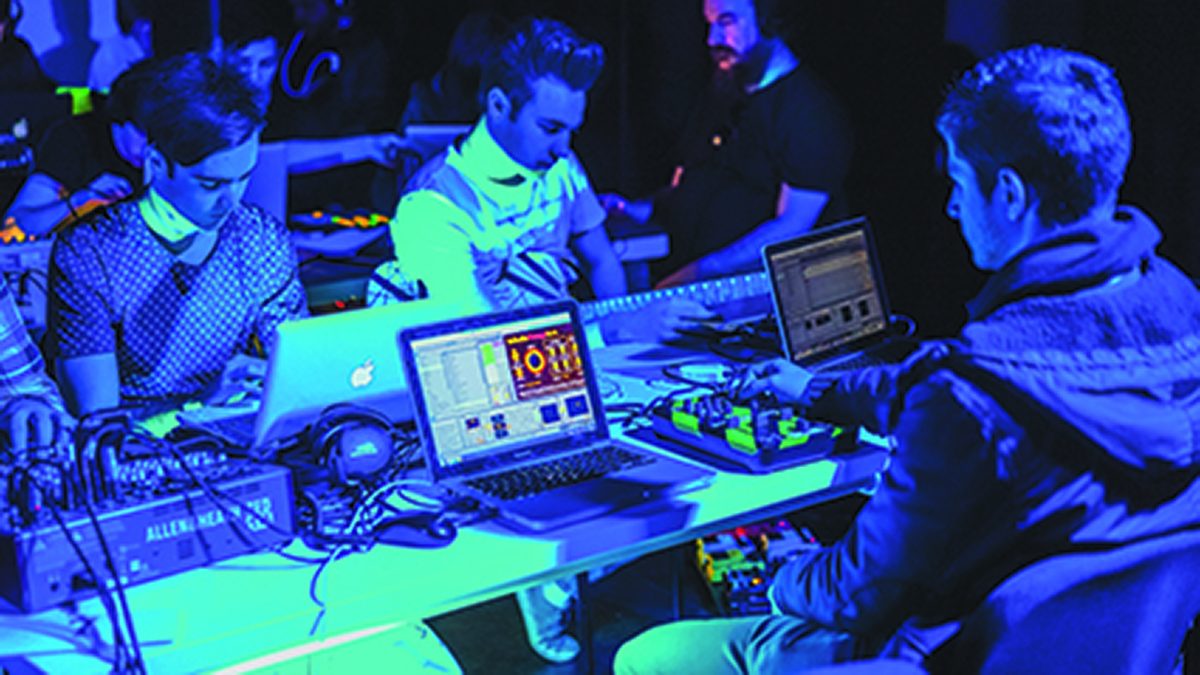
Laptop Orchestra, Electronic Music Unit, Elder Conservatorium of Music, Adelaide, Tectonics, photo Dr Sebastian Tomczak
Stephen Whittington’s work with his students in the Sonic Arts program at the University of Adelaide shows how musical training has not only accompanied but generated musical evolution. He and his students regularly conduct concerts such as the 2014 concert, Stockhausen, May 1968: Intuition and Liberation, where 47 Bachelor of Music (Sonic Arts) students realised Stockhausen’s Aus den Sieben Tagen (1968). “The students work in groups of four or five with an array of synthesisers, the ubiquitous laptops, a tape-loop, the occasional electric guitar and even voice…[The] script is almost a blank canvas for the performer, and can be seen both as a form of spiritual liberation and the ritual abandonment of conventional composition…That the performers can make such interesting music with so little direction indicates the depth of their creativity and their technical, improvisational and ensemble skills” [RT122].
And then, perhaps inevitably, came Whittington’s laptop orchestra of 2015 — the 65-member Electronic Noise Orchestra, piloted by two mixers and a master-mixer. “The resulting sound was characterised by dense musical layering that made full use of the eight loudspeakers placed around the perimeter of the auditorium to create a sense of swirling movement. Hearing it was an incredible experience as the complex sound patterns developed and intersected in kaleidoscopically fascinating ways” [RT128].
Whittington has a clear educational and musical philosophy: “I see sonic art as a category that is larger than music — though music is a part of it — a category that embraces every kind of art activity that uses or references sound… My approach is phenomenological — my students are forced to come to grips with ideas from Husserl and Merleau-Ponty at some time or other…” [RT128].
Mainstreaming new music
It was also inevitable that the latest in musical developments would be showcased through mainstream arts festival programs. Sydney’s NOW Now, Perth’s Totally Huge New Music Festival and the almost national Liquid Architecture series (sadly, LA never reached Adelaide) have brought us the newest musical developments for some years, but the Tectonics programs of 2014 [RT120] and 2016 [RT131] and the Unsound programs (2013-2106) that David Sefton featured in the Adelaide Festival of Arts have extended contemporary music’s reach beyond its typical niche audience. From 2017, Unsound has become a separate festival, bringing to Adelaide world class performers, composers and cutting edge experimental music. “Unsound Adelaide was outstanding in its conception and delivery, adding a crucially important dimension to musical programming in Australia.”
In the quarter-century spanned by Real Time, we have witnessed a revolutionary transformation of musical composition, performance and reception. Additionally, you can now access almost any music through the internet, anywhere, anytime. One even wonders if some form of bio-electronic telepathy will soon replace the smart phone + earbuds. The pace of musical change parallels the evolution of technology and the way in which audiences apprehend and interact with the world around them. The future of music is already being encoded. Forget the stars and navigate with your cursor.
–
Chris Reid is an Adelaide-based writer who has reviewed visual arts and music for RealTime since 1999. Read about him here.
Top image credit: Eugene Ughetti, Speak Percussion, The Glass Percussion Project, 2009, photo Andrew Barcham


